Sercomm ICAMERA2 Wireless Network Camera User Manual iCamera2 Manual v1 1
Sercomm Corporation Wireless Network Camera iCamera2 Manual v1 1
Sercomm >
User manual
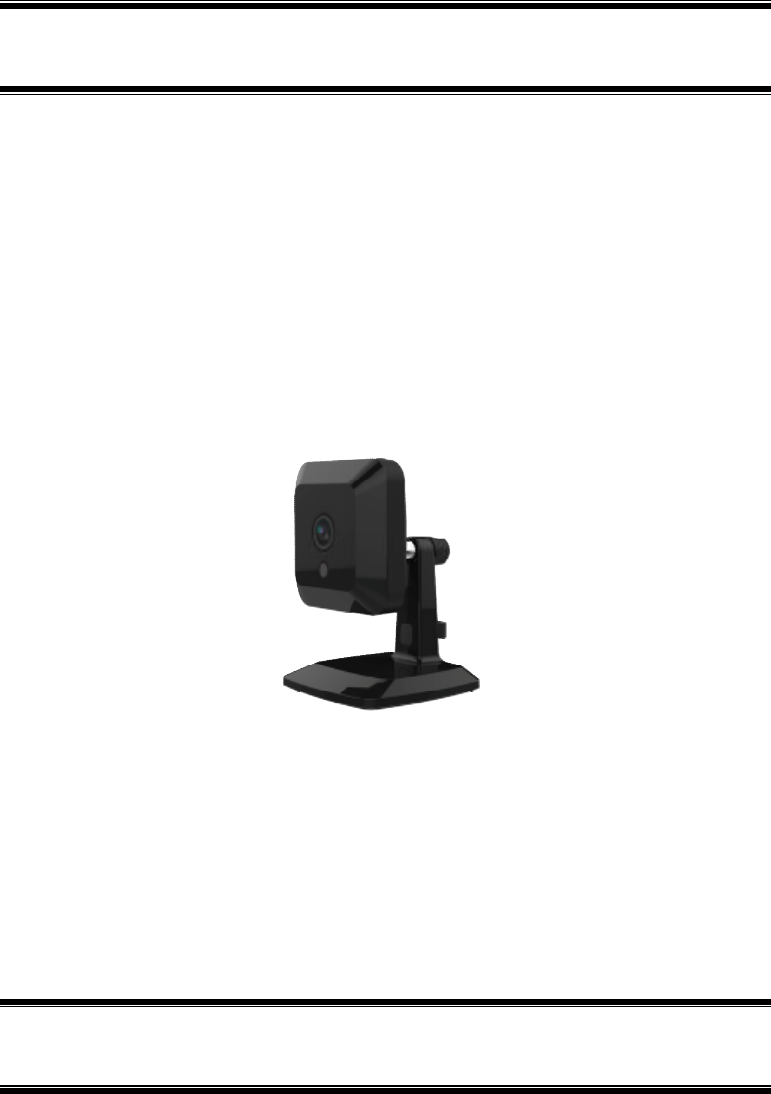
iCamera2
User’s Guide

Table of Contents
CHAPTER 1 INTRODUCTION .......................................................................................... 1
Overview ....................................................................................................................... 1
Physical Details - iCamera2 .......................................................................................... 3
Package Contents .......................................................................................................... 5
CHAPTER 2 BASIC SETUP ............................................................................................... 6
System Requirements ................................................................................................... 6
Installation - iCamera2 ................................................................................................. 6
Wall Mounting .............................................................................................................. 9
CHAPTER 3 VIEWING LIVE VIDEO ............................................................................. 10
Overview ..................................................................................................................... 10
Requirements .............................................................................................................. 10
Connecting to a Camera on your LAN ....................................................................... 10
Connecting to a Camera via the Internet ................................................................... 12
Viewing Live Video ..................................................................................................... 14
CHAPTER 4 ADVANCED VIEWING SETUP................................................................. 16
Introduction ................................................................................................................ 16
Adjusting the Video Image ......................................................................................... 16
Controlling User Access to the Video Stream............................................................. 19
Making Video available from the Internet ................................................................. 20
Viewing Live Video via the Internet ........................................................................... 21
Motion Detection Alerts .............................................................................................. 22
CHAPTER 5 WEB-BASED MANAGEMENT .................................................................. 23
Introduction ................................................................................................................ 23
Connecting to iCamera2 ............................................................................................. 23
Welcome Screen .......................................................................................................... 24
Administration Menu ................................................................................................. 25
System Screen ............................................................................................................. 26
Network Screen ........................................................................................................... 28
Wireless Screen ........................................................................................................... 32
DDNS Screen............................................................................................................... 35
IP Filter ....................................................................................................................... 37
Streamings .................................................................................................................. 38
Video & Audio Screen ................................................................................................ 41
Video Access Screen .................................................................................................... 43
User Database Screen ................................................................................................. 45
Pan/Tilt Screen............................................................................................................ 46
Motion Detection Screen ............................................................................................. 48
Audio Detection Screen ............................................................................................... 49
E-Mail Screen ............................................................................................................. 50
FTP Screen .................................................................................................................. 51
HTTP Screen............................................................................................................... 52
Trigger & Recording Screen....................................................................................... 54
Maintenance Screen .................................................................................................... 57
Status Screen ............................................................................................................... 59
Log Screen................................................................................................................... 61
CHAPTER 7 TROUBLESHOOTING ............................................................................... 62
Overview ..................................................................................................................... 62
Problems ..................................................................................................................... 62
APPENDIX A SPECIFICATIONS .................................................................................... 64
iCamera2 ..................................................................................................................... 64
Regulatory Approvals ................................................................................................. 64
Copyright 2014. All Rights Reserved.
Document Version: 1.0
All trademarks and trade names are the properties of their respective owners.

1
Chapter 1
Introduction
This Chapter provides details of the iCamera2's features, components and
capabilities.
Overview
The iCamera2 has an Integrated Microcomputer and a high quality CMOS Sensor, enabling it
to display high quality live streaming video over your wired LAN, the Internet, and for the
iCamera2, an 802.11N Wireless LAN.
Using enhanced H.264 technologies, the iCamera2 is able to stream high quality video and
audio directly to your PC. The high compression capabilities of H.264 reduce network
bandwidth requirements to amazingly low levels.
Furthermore, with the built-in infrared LEDs, the Wireless IP camera can provide illumination
around 5 meters long under low light conditions in a simple, economical manner.
Features
• Standalone Design. The iCamera2 is a standalone system with built-in CPU and Video
encoder. It requires only a power source and a connection to your LAN or Wireless LAN.
• Dual Video Support. The iCamera2 can support H.264 and MJEPG video for different
image compression.
• Stream Live Video to Multiple Users. The video encoder and HTTP server built into
the camera generate a ready-to-view video stream. Just connect to the camera using your
Web browser to view live video.
• Suitable for Home, Business or Public Facilities. Whether for Home, Business or
Public Facility surveillance, or just for entertainment and fun, the iCamera2 has the
features you need.
• Multi-Protocol Support. Supporting TCP/IP networking, HTTP and other Internet
related protocols, the iCamera2 can be easily integrated into your existing network.
• IR LEDs Support. Each iCamera2 has two infrared LEDs. The LEDs can provide
illumination around 5 meters long, that can help to output a better video quality while
under low-light conditions such as indoors, on cloudy days, or in the morning or evening.
• Motion Detection. This feature can detect motion in the field of view. The iCamera2
will compare consecutive frames to detect changes caused by the movement of large
objects. This function only works indoors due to the sensitivity of the CMOS sensor.
When motion is detection or some other action may be triggered.
• Flexible Scheduling. You can limit access to the video stream to specify times using a
flexible scheduling system. The Motion Detection feature can also have its own schedule,
so it is active only when required.
• Syslog Support. If you have a Syslog Server, the iCamera2 can send its log data to your
Syslog Server.
• Audio Support. You can listen as well as look! Audio is encoded with the video if
desired. With built-in microphone, it is useful for bi-direction voice conversation.
1

2
• Day/Night Switch. With the day/night switching feature, you are able to view and record
better images even in the dark of night.
Internet Features
• User-definable HTTP/HTTPS port number. This allows Internet Gateways to use
"port mapping" so the iCamera2 and a Web Server can share the same Internet IP address.
• NTP (Network-Time-Protocol) Support. NTP allows the iCamera2 to calibrate its
internal clock from an Internet Time-Server. This ensures that the time stamp on Video
from the iCamera2 will be correct.
Security Features
• User Authentication. If desired, access to live video can be restricted to known users.
Users will have to enter their username and password before being able to view the video
stream.
• Password-Protected Configuration. Configuration data can be password protected, so
that it only can be changed by the iCamera2 Administrator.
Wireless Features
• Supports 11n Wireless Stations. The 802.11n standard provides for backward
compatibility with the 802.11b standard, so 802.11n, 802.11b and 802.11g Wireless
stations can be used simultaneously.
• Wired and Wireless Network Support. The iCamera2 supports either wired or wireless
transmission.
• WEP Support. Full WEP support (64/128 Bit) on the Wireless interface is provided.
• WPA/WPA2 Support. The WPA Personal/WPA2 Personal standard is also supported,
allowing advanced encryption of wireless data.
• WPS Support. WPS (Wi-Fi Protected Setup) can simplify the process of connecting any
device to the wireless network by using the push button configuration (PBC) on the
iCamera2, or entering a PIN code if there's no button.
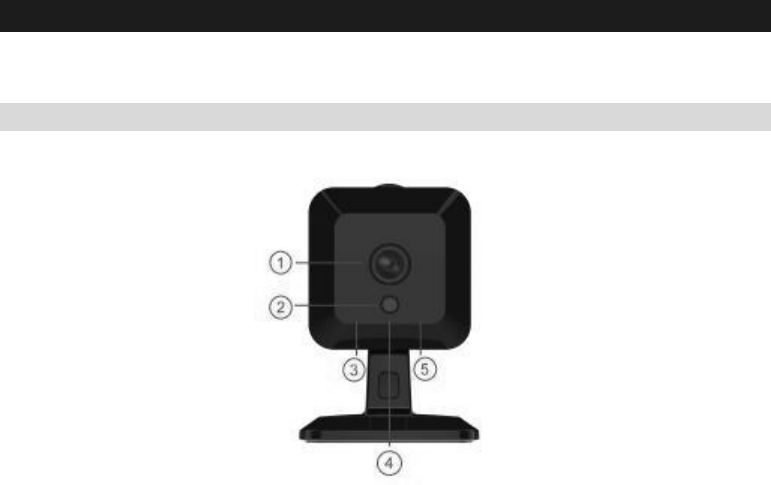
3
Physical Details - iCamera2
Front - iCamera2
Figure 1: Front Panel
1. Light Sensor This is hardware sensor to detect LUX.
2. Lens No physical adjustment is required or possible for the lens, but you
should ensure that the lens cover remain clean. The image quality is
degraded if the lens cover is dirty or smudged.
3. POWER/WiFi
indicator (Green) On (Green) - Power is on.
Off - Power is off.
Flashing - Wifi signal-strength indication.
The LED indicates SNR for the first 5 minutes after the camera is
powered on. Then it will stay solid to indicate power LED for 5
minutes when wireless setup is ready.
• Flashing Low at 1/2Hz - WiFi signal is weak, SNR < 15 dB
• Flashing Middle at 2Hz - WiFi signal is acceptable, SNR
15-22 dB
• Flashing High at 5Hz - WiFi signal is strong, SNR > 22 dB
4. Network
indicator (Green) On - LAN/Wireless connection established.
Off - No active connection on the corresponding LAN port, or not
associated to Wireless AP.
Flashing - Data is being transmitted or received.
5. WPS indicator
(Green) On - If the WPS association fails, the WPS LED will be on
continuously for 5 seconds.
Off - WPS function is off.
Flashing - WPS association is in process. The LED goes off when
the connection is complete.
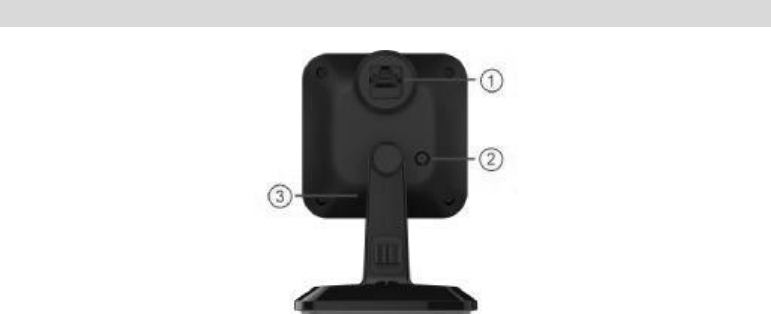
4
Rear - iCamera2
Figure 2: Rear Panel
1. LAN Port Use standard Ethernet cable (RJ45 connectors) to connect your PC
to the port for installation and configuration. The port is also used
for power connection when the camera is under wireless mode. A
customized PoE (Power over Ethernet) splitter, as a Y-cable, for
both Ethernet and DC Jack is provided.
2.WPS/Reset This button has two (2) functions:
• WPS.
• WPS PBC Mode
1. Turn on the camera without connecting the Ethernet cable.
2. Wait for three minutes, and then press and release (less then 3
seconds). The WPS LED will start blinking. Press the WPS
button on the gateway within two minutes.
3. The WPS LED will be off and the Network LED will be on if
the connection is successful.
• WPS Pin Code Mode
1. Turn on the wireless camera without connecting the Ethernet
cable.
2. Wait for three minutes, and then press and hold the button for
over three seconds (3 ~ 10 seconds). The WPS LED will start
blinking.
Get the pin code in the "WSC PIN Code" field of Wireless
screen (camera’s web interface). Enter the pin code on the
gateway within two minutes.
3. The WPS LED will be off and the Network LED will be on if
the connection is successful.
• Reset.
1. Power On.
2. Keep holding the button down for 10 seconds, then release.
3. Microphone The built-in microphone is located on the rear of the device.

5
Package Contents
The following items should be included: If any of these items are damaged or missing, please
contact your dealer immediately.
1. iCamera2 x 1
2. Stand x 1
3. Y-cable x 1
4. DC Cable x 1
5. Ethernet Cable x 1
6. RJ45 Cap x 1
7. Power Adapter x 1
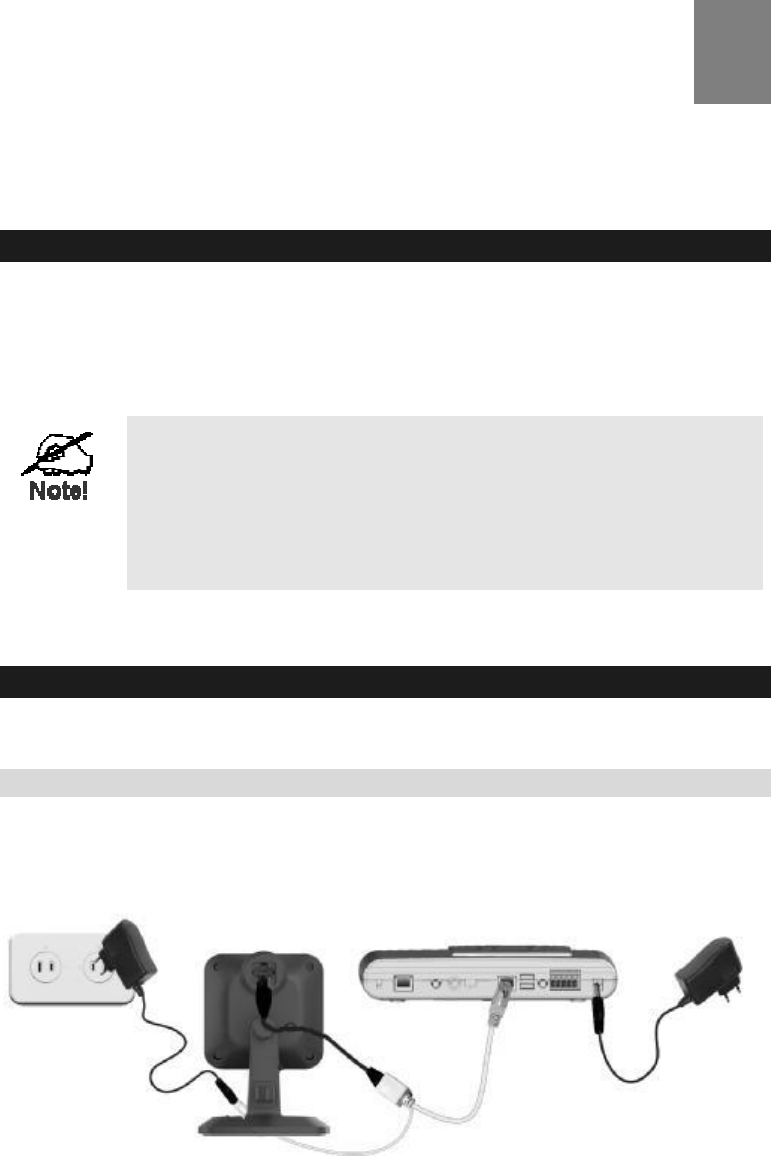
6
Chapter 2
Basic Setup
This Chapter provides details of installing and configuring the iCamera2.
System Requirements
• To use the wired LAN interface, a standard 10/100BaseT hub or switch and network cable
is required.
• To use the Wireless interface on the wireless model, other Wireless devices must be
compliant with the IEEE802.11b, IEEE802.11g or IEEE 802.11n specifications. All
Wireless stations must use compatible settings.
The default Wireless settings are:
Mode: Infrastructure
SSID: ANY
Wireless Security: Disabled
Domain: USA
Channel No.: Auto
Installation - iCamera2
Step 1 - Initial Setup
Initial setup is required when the iCamera2 is used for the FIRST time. It only needs to be done
ONCE in order to configure the wireless settings for the iCamera2.
Note: Skip this section if the iCamera2 has been set up already.
Figure 3: Initial Setup
2

7
1. Assemble the Camera
a. Hold the metal screw of the stand up.
b. Face the back of the iCamera2 to the stand and turn the iCamera2 clockwise to attach
it to the stand.
2. Connect the Y-cable
Connect the provided Y-cable (with Ethernet) to the LAN port of iCamera2.
The wireless and wired modes cannot work
simultaneously. It is recommended to first
configure the wireless settings of an iCamera2
using wired mode. After configuration, disconnect
the wire and power, and power on the iCamera2
again. Then, it will be ready for wireless operation.
3. Connect the Router
Use the Ethernet cable to connect the Y-cable and connect the other end to the LAN port
of the router.
4. Power Up
Connect the supplied power adapter to the Y-cable and power up. Use only the power
adapter provided. Using a different one may cause hardware damage.
5. Check the LEDs
• The Power LED will turn on briefly, then start blinking. It will blink during startup, which
takes 15 to 20 seconds. After startup is completed, the Power LED should remain ON.
• The Network LED should be ON.
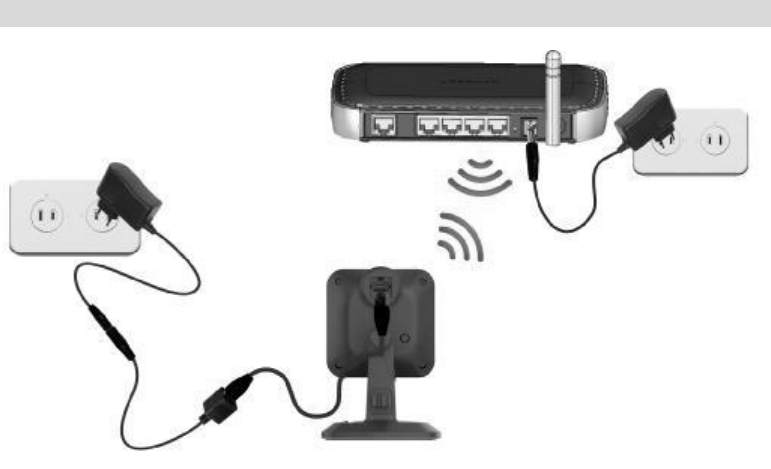
8
Step 2 - Installation
Figure 4: Installation
1. Disassemble the Camera
Unplug the Y-cable and power off the camera.
2. Connect the Ethernet cable
Connect the Ethernet cable to the LAN port of the iCamera2.
3. Power Up
Connect the DC cable to the Ethernet cable.
Connect the supplied power adapter to the DC cable to power up the iCamera2. Use only
the power adapter provided. Using a different one may cause hardware damage.
4. Check the LEDs
• The Power LED will turn on briefly, then start blinking. It will blink during startup, which
takes 15 to 20 seconds. After startup is completed, the Power LED should remain ON.
• The Network LED should be ON.
For more information, refer to Physical Details - iCamera2 in Chapter 1.
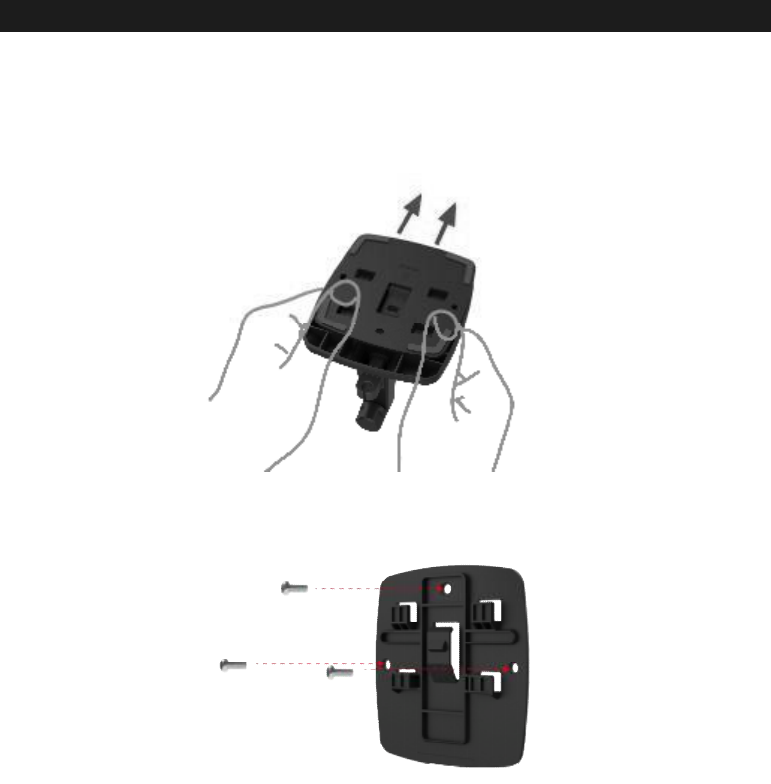
9
Wall Mounting
*Note: Please ensure that the iCamera2 is configured and added to the network before
permanent mounting.
1. Using hands to remove the plate from the bottom of the stand.
2. Place the plate in the desired position of the wall. Screw three screws into ceiling through
the holes of the plate.
3. Attach the stand to the plate.
4. Connect the LAN cable into the LAN port of the device. Turn the iCamera2 clockwise to
attach it to the stand.
5. Connect the other end of the LAN cable to the adapter through the holes of the stand.
Adjust it to the desired position and secure the iCamera2 firmly.

10
Chapter 3
Viewing Live Video
This Chapter provides basic information about viewing live video.
Overview
This Chapter has details of viewing live video using Internet Explorer.
But many other powerful features and options are available:
• The camera administrator can also adjust the Video Stream, and restrict access to the video
stream to known users by requiring viewers to supply a username and password. See
Chapter 4 - Advanced Viewing Setup for details.
• To make Live Video from the camera available via the Internet, your Internet Gateway or
Router must be configured correctly. See Making Video available from the Internet in
Chapter 4 - Advanced Viewing Setup for details.
Requirements
To view the live video stream generated by the iCamera2, you need to meet the following
requirements:
• Windows XP, 32-bit Windows Vista/Windows 7.
• Internet Explorer 7 or later, Firefox 3.0 or later.
Connecting to a Camera on your LAN
To establish a connection from your PC to the iCamera2:
1. Start Internet Explorer.
2. In the Address box, enter "HTTP://" and the IP Address of the iCamera2.
3. When you connect, the following screen will be displayed.
3
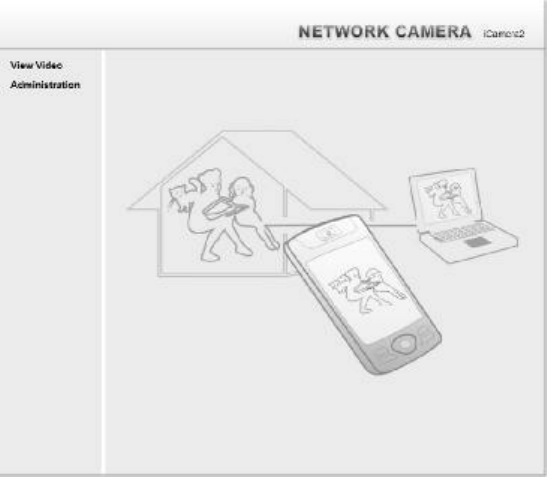
11
Figure 5: Home Screen
4. Click View Video.
5. If the Administrator has restricted access to known users, you will then be prompted for a
username and password.
Enter the name and password assigned to you by the iCamera2 administrator.
6. The first time you connect to the camera, you will be prompted to install decoders.
Choose "I accept the terms of the license agreement" and click "OK".
7. Video will start playing automatically. There may be a delay of a few seconds while the
video stream is buffered.

12
Connecting to a Camera via the Internet
You can NOT connect to a camera via the Internet unless the camera
Administrator has configured both the camera and the Internet Gateway/Router
used by the camera.
See Making Video available from the Internet in Chapter 4 - Advanced Viewing Setup for
details of the required configuration.
Also, you need a broadband Internet connection to view video effectively. Dial-up connections
are NOT supported.
To establish a connection from your PC to the iCamera2 via the Internet:
1. Obtain the following information from the Administrator of the camera you wish to
connect to:
• Internet IP Address or Domain Name of the camera.
• Port number for HTTP connections.
• Login (username, password) if required.
2. Start Internet Explorer.
3. In the Address box, enter the following:
HTTP://Internet_Address:port_number
Where Internet_Address is the Internet IP address or Domain Name of the camera,
and port_number is the port number used for HTTP (Web) connections to the camera.
Examples using an IP address:
HTTP://203.70.212.52:1024
Where the Internet IP address is 203.70.212.52 and the HTTP port number is 1024.
4. When you connect, the following screen will be displayed.
Figure 6: Home Screen
13
5. Click View Video.
6. If the Administrator has restricted access to known users, you will then be prompted for a
username and password.
Enter the name and password assigned to you by the iCamera2 administrator.
7. The first time you connect to the camera, you will be prompted to install decoders.
Choose "I accept the terms of the license agreement" and click "OK".
8. Video will start playing automatically. There may be a delay of a few seconds while the
video stream is buffered.
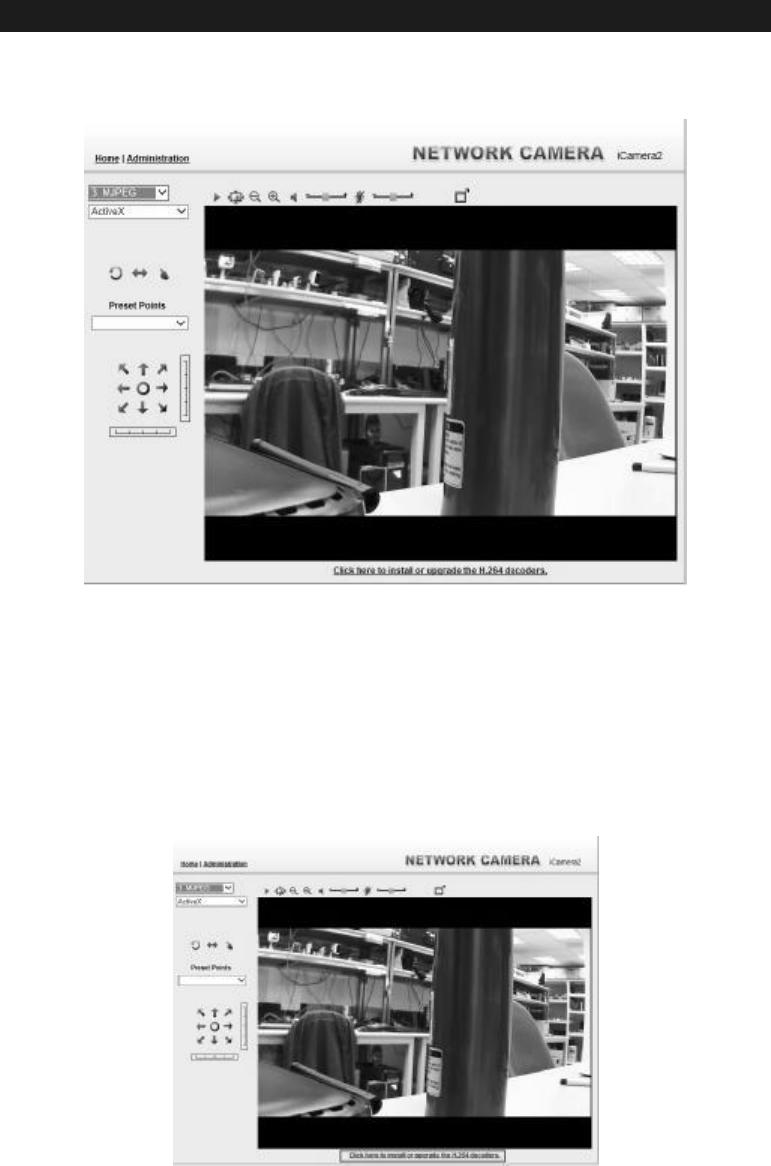
14
Viewing Live Video
After installing the decoders, you will be able to view the live video stream in its own window,
as shown below.
Figure 7: View Video Screen
There are a number of options available on this screen, accessed by select list, button or icon.
See the table below for details.
Note: The options can only be configured while using IE browser. Other browsers can just
view the video rather than configuration.
If the video still cannot be viewed, please install the decoders to solve this problem. You can
install it from the following screens:
• View Video Screen (preferred)
Figure 8: Install Decoders
• Motion Detection Screen
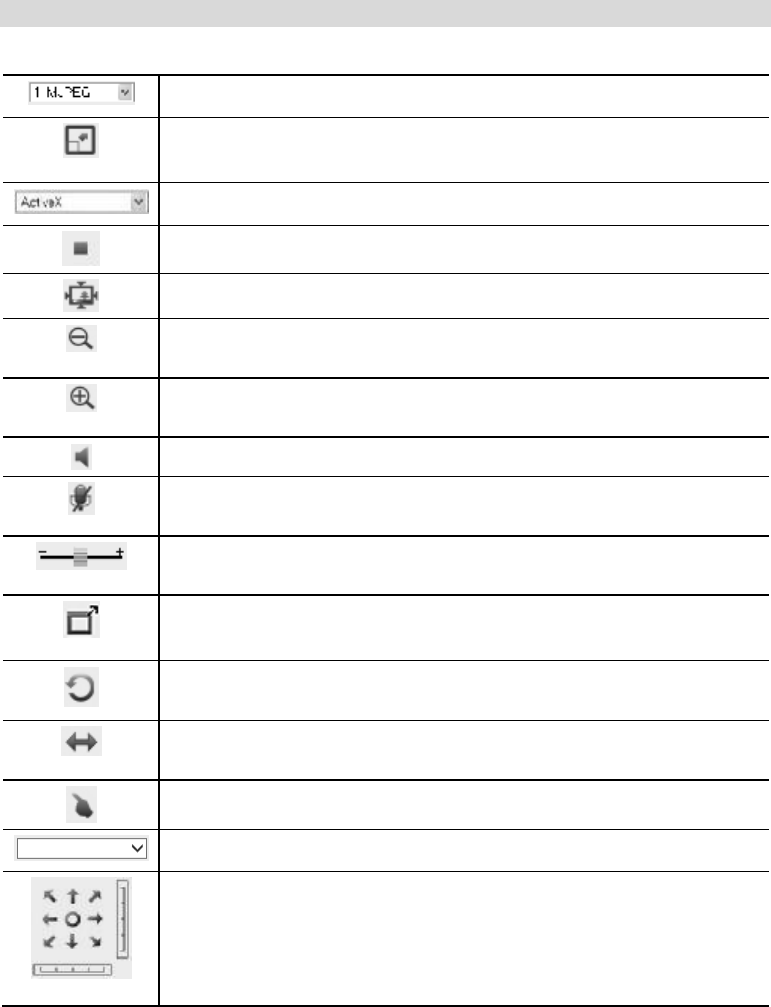
15
General Options
These options are always available, regardless of the type of camera you are connected to.
Streaming. Use this drop-down list to select the desired streaming.
Full Size. When using high-resolution mode (1280*720), click this
button to see the full size of the image.
Select the desired option from the drop-down list.
Use this icon to start/stop viewing.
Use this icon to make the image back to original size.
Zoom Out. A digital zoom out feature is available. To zoom out the
window, click this icon.
Zoom In. A digital zoom in feature is available. To zoom in the
window, click this icon.
Speaker On/Off. Use this button to turn the PC's speaker on or off.
Audio Upload On/Off. Use this button to toggle the microphone on or
off.
Volume. If Speaker or Microphone is enabled, use this slider to adjust
the volume.
Full Screen Display. Click this button to see the full screen of the
image.
Camera Patrol. Move through the Preset positions in the sequence
defined by the Camera Administrator.
Camera Auto Pan. Click this to have the camera moved from left to
right automatically.
Direct P/T. Use this to move the camera to the Pan/Tilt position directly.
Preset Points. Select the desired Preset points.
Move Control. Use this to move the camera to the desired position.
There may a short delay after clicking the desired icon. You should wait
a couple of seconds rather than click again.
Or you can drag the vertical or horizontal slider bar to have quicker
movement of the Network Camera to the desired position.
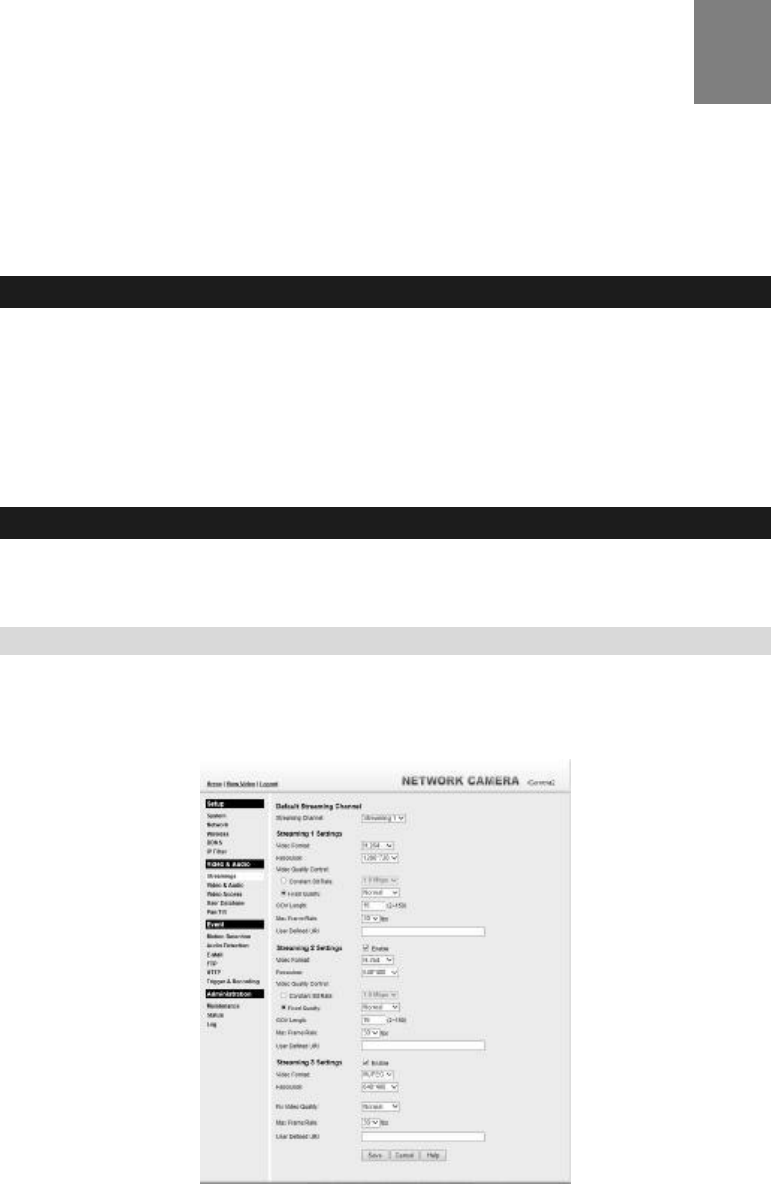
16
Chapter 4
Advanced Viewing Setup
This Chapter provides information about the optional settings and features for
viewing video via the iCamera2. This Chapter is for the Camera
Administrator only.
Introduction
This chapter describes some additional settings and options for viewing live Video:
• Adjusting the video image
• Controlling user access to the live video stream
• Making video available from the Internet
• Using the Motion Detection feature
Adjusting the Video Image
If necessary, the iCamera2 Administrator can adjust the Video image.
To Adjust the Video Image:
9. Connect to the Web-based interface of the iCamera2. (See Chapter 5 - Web-based
Management for details.)
10. Select Administration, then Streamings. You will see a screen like the example below.
Figure 9: Streamings Screen
11. Make the required adjustments, as explained below, and save your changes.
4

17
Default Streaming
Channel Select the default channel for streaming from the drop-down list.
Streaming 1 Settings
Video Format Select the desired format from the list.
Resolution Select the desired video resolution format.
Video Quality
Control
•
Constant Bit Rate: Select the desired bit rate. The default is set
to 2.0 Mbps.
• Fixed Quality: Select the desired option. The default fix quality
is set to Normal.
Fixed Video
Quality There are five options:
• Very Low
• Low
• Normal
• High
• Very High
GOV Length Adjust the GOV interval in frame base. "2" means 1 I frame and 1 P
Frame. "3" means 1 I frame and 2 P Frames. Enter the desired value
between 2 and 150.
Max. Frame Rate Select the desired Maximum frame rate for the video stream.
The default value is 30.
User Defined URI You may enter the URI up to 32 characters long for accessing the
live video from camera through cell phone connection.
Streaming 2/3 Settings
Enable Check the box if you want to enable the streaming.
Video Format Select the desired format from the list.
Resolution Select the desired video resolution format.
Video Quality
Control
•
Constant Bit Rate: Select the desired bit rate. The default is set
to 1.0 Mbps.
• Fixed Quality: Select the desired option. The default fix quality
is set to Normal.
Fixed Video
Quality There are five options:
• Very Low
• Low
• Normal
• High
• Very High
GOV Length Adjust the GOV interval in frame base. "2" means 1 I frame and 1 P
Frame. "3" means 1 I frame and 2 P Frames. Enter the desired value
between 2 and 150.
Max. Frame Rate Select the desired Maximum frame rate for the video stream.
The default value is 20.

18
User Defined URI You may enter the URI up to 32 characters long for accessing the
live video from camera through cell phone connection.
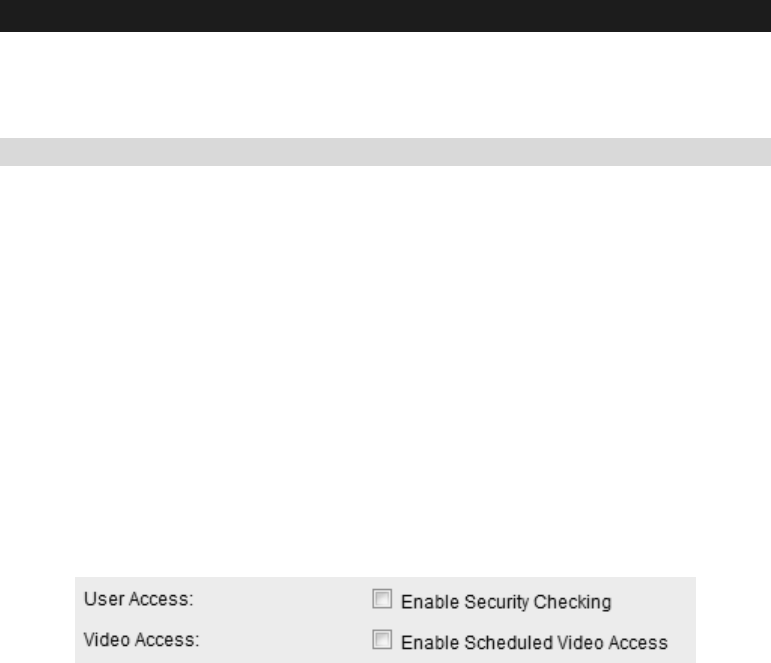
19
Controlling User Access to the Video Stream
By default, anyone can connect to the iCamera2 and view live Video at any time.
If desired, you can limit access to scheduled times, and also restrict access to known users.
To Control User Access to Live Video:
1. Connect to the Web-based interface of the iCamera2. (See Chapter 5 - Web-based
Management for details.)
2. Select Administration, then Video Access.
3. Set the desired options for Access.
Access
Select the desired option as required:
• If the User Access is enabled, users will be prompted for a username and password when
they connect to the camera for viewing video.
• When Video Access is enabled, viewing video is only available during the scheduled
periods, and unavailable at other times. If this option is selected, you need to define a
schedule; otherwise it is always disabled.
However, viewing video is still possible by logging in as the Administrator.
Figure 10: Controlling User Access
See Chapter 5 - Web-based Management for further details about using the Video Access and
User Database screens.
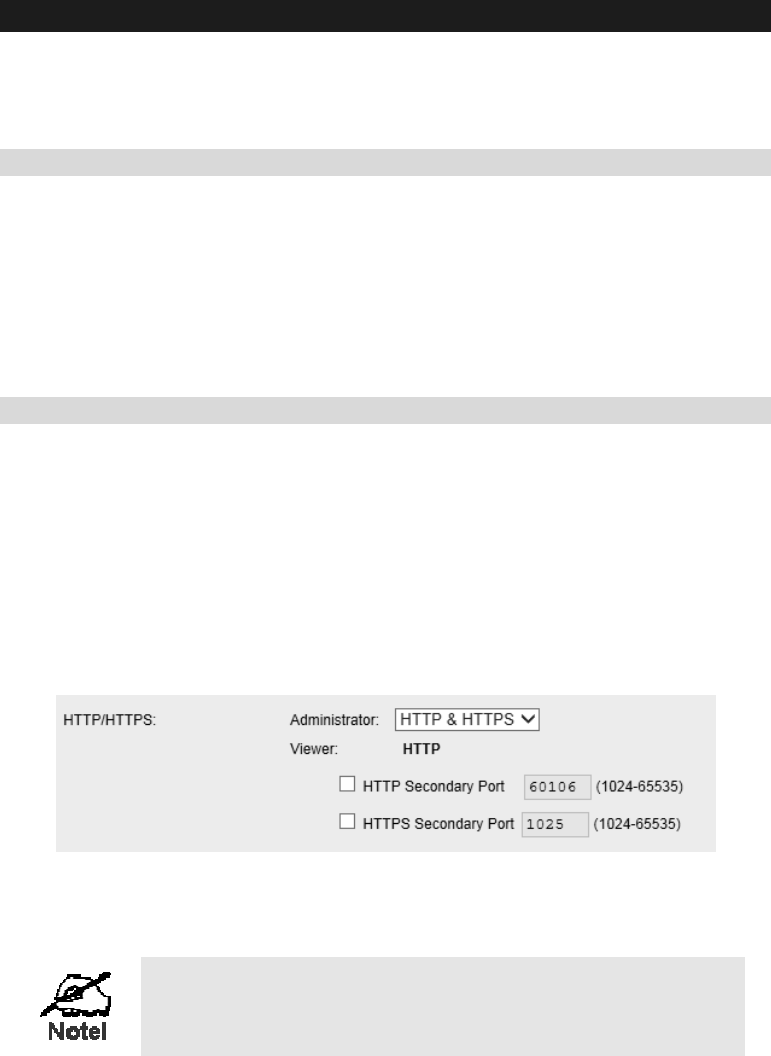
20
Making Video available from the Internet
If your LAN is connected to the Internet, typically by a Broadband Gateway/Router and
Broadband modem, you can make the iCamera2 available via the Internet. You will need to
configure your Router or Gateway to allow connections from the Internet to the camera.
Router/Gateway Setup
Your Router or Gateway must be configured to pass incoming TCP (HTTP) connections (from
Internet Viewers) to the iCamera2. The Router/Gateway uses the Port Number to determine
which incoming connections are intended for the iCamera2.
This feature is normally called Port Forwarding or Virtual Servers. The Port
Forwarding/Virtual Server entry tells the Router/Gateway that incoming TCP connections on
port 1024 should be passed to the iCamera2. If necessary, check the user manual for your
Router/Gateway for further details.
iCamera2 Setup
The iCamera2 configuration does NOT have to be changed, unless:
• You wish to change the port number from the default value.
HTTPS Port Configuration
Normally, HTTP (Web) connections use port 80. Since the iCamera2 uses HTTP, but port 80 is
likely to be used by a Web Server, you can use a different port for the iCamera2. This port is
called the Secondary Port.
The default HTTP/HTTPS Secondary Port is 1025. If you prefer to use a different port number,
you can specify the port number on the iCamera2's Network screen, as shown below.
Figure 11: Network Screen
See Chapter 5 - Web-based Management for further details on using the Network screen.
Viewers need to know this port number in order to connect
and view live Video, so you must inform viewers of the
correct port number.
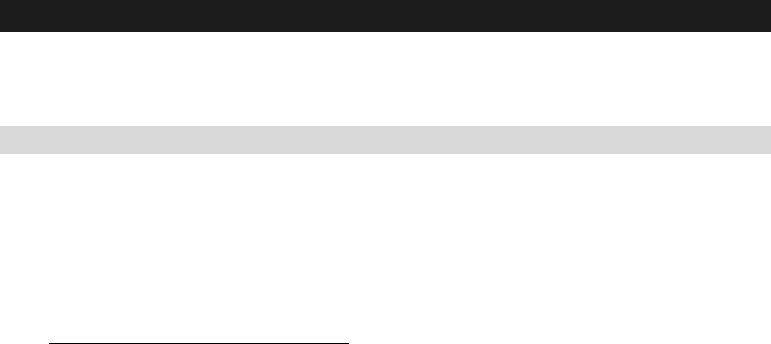
21
Viewing Live Video via the Internet
Clients (viewers) will also need a broadband connection; dial-up connections are NOT
recommended.
Viewing Live Video Using your Web Browser
If using your Web browser, you need to know the Internet IP address (or the Domain name) of
the camera's Router/Gateway, and the correct port number.
Enter the Internet address of the Router/Gateway, and its port number, in the Address (or
Location) field of your Browser.
Example - IP address:
HTTP://203.70.212.52:1024
Where the Router/Gateway's Internet IP address is 203.70.212.52 and the "Secondary
Port" number on the iCamera2 is 1024.
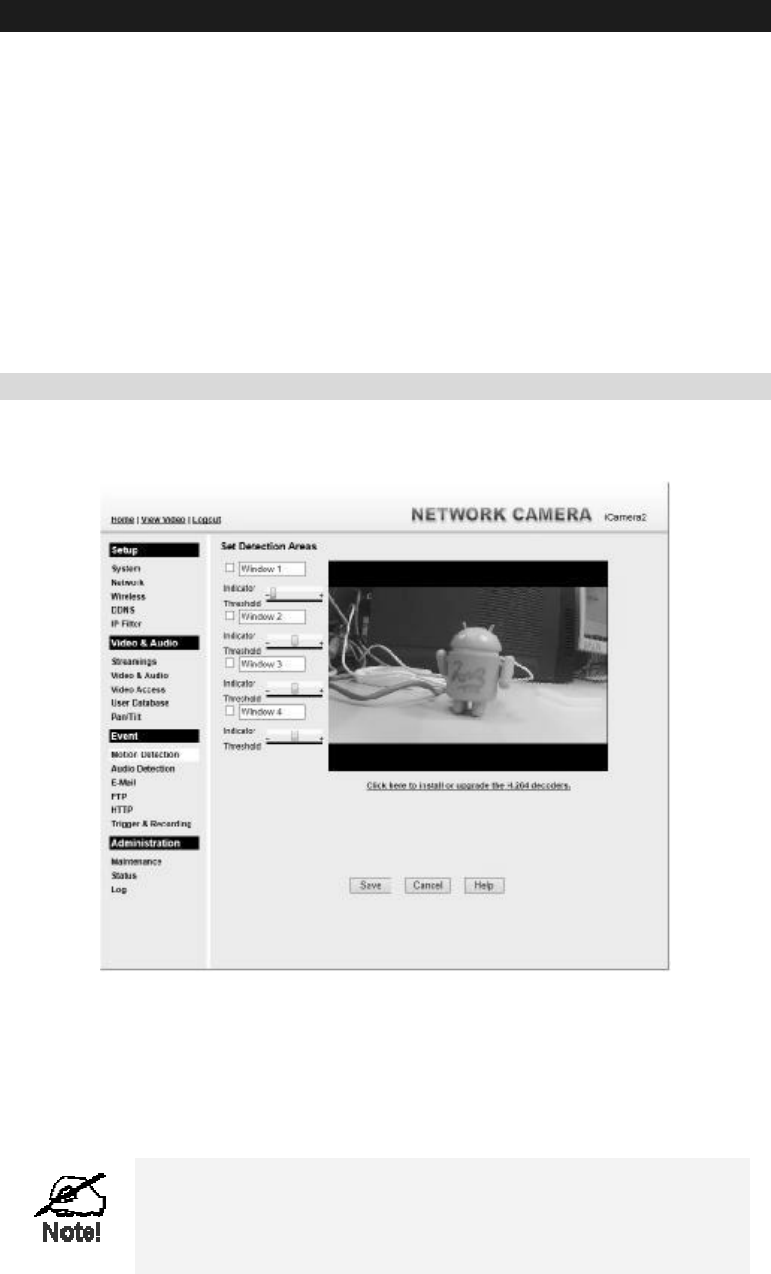
22
Motion Detection Alerts
The Motion Detection feature can generate an Alert when motion is detected.
The iCamera2 will compare consecutive frames to detect changes caused by the movement of
large objects.
But the motion detector can also be triggered by:
• Sudden changes in the level of available light
• Movement of the camera itself.
Try to avoid these situations. The motion detection feature works best in locations where there
is good steady illumination, and the camera is mounted securely. It cannot be used outdoors
due to the sensitivity of the CMOS sensor.
Note: The Motion Detection settings can only be configured while using IE browser.
To Use Motion Detection Alerts
Using the Web-based interface on the iCamera2, select the Motion Detection screen, then
configure this screen as described below.
Figure 12: Motion Detection
1. Enable the Motion Detection feature.
2. Set the area or areas of the video image to be examined for movement. You can define up
to 4 areas, and set the motion threshold individually for each area.
3. If using a schedule, define the desired schedule in Trigger & Recording screen.
4. Save your changes.
If the Motion Detection feature is enabled, but the related
options in the Trigger & Recording screen are not enabled,
then the only action when motion is detected is to log this
event in the system log.

23
Chapter 5
Web-based Management
This Chapter provides Setup details of the iCamera2’s Web-based Interface.
This Chapter is for the Camera Administrator only.
Introduction
The iCamera2 can be configured using your Web Browser. The iCamera2 must have an IP
address which is compatible with your PC.
Connecting to iCamera2
• If using only your Web Browser, use the following procedure to establish a connection
from your PC to the iCamera2:
• Once connected, you can add the iCamera2 to your Browser's Favorites or Bookmarks.
Connecting using your Web Browser
1. Start your WEB browser.
2. In the Address box, enter "HTTP://" and the IP Address of the iCamera2.
3. You will then be prompted for a username and password.
• If using the default values, enter administrator for the name, and leave the
password blank.
• Otherwise, enter the Administrator ID and Administrator Password set on the
Maintenance screen.
5
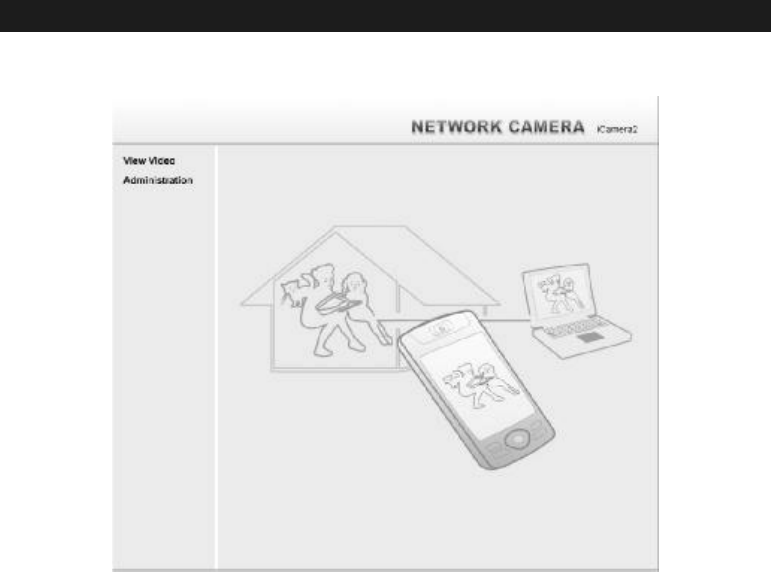
24
Welcome Screen
When you connect, the following screen will be displayed.
Figure 13: Welcome Screen
The menu options available from this screen are:
• View Video - View live Video using your Web Browser. See Chapter 3 - Viewing Live
Video for details.
• Administration - Access the Administration menu.

25
Administration Menu
Clicking on Administration on the menu provides access to all the settings for the iCamera2.
The Administration menu contains the following options:
Setup
• System
• Network
• Wireless
• DDNS
• IP Filter
Video & Audio
• Streamings
• Video & Audio
• Video Access
• User Database
• Pan/Tilt
Event
• Motion Detection
• Audio Detection
• E-Mail
• FTP
• HTTP
• Trigger & Recording
Administration
• Maintenance
• Status
• Log
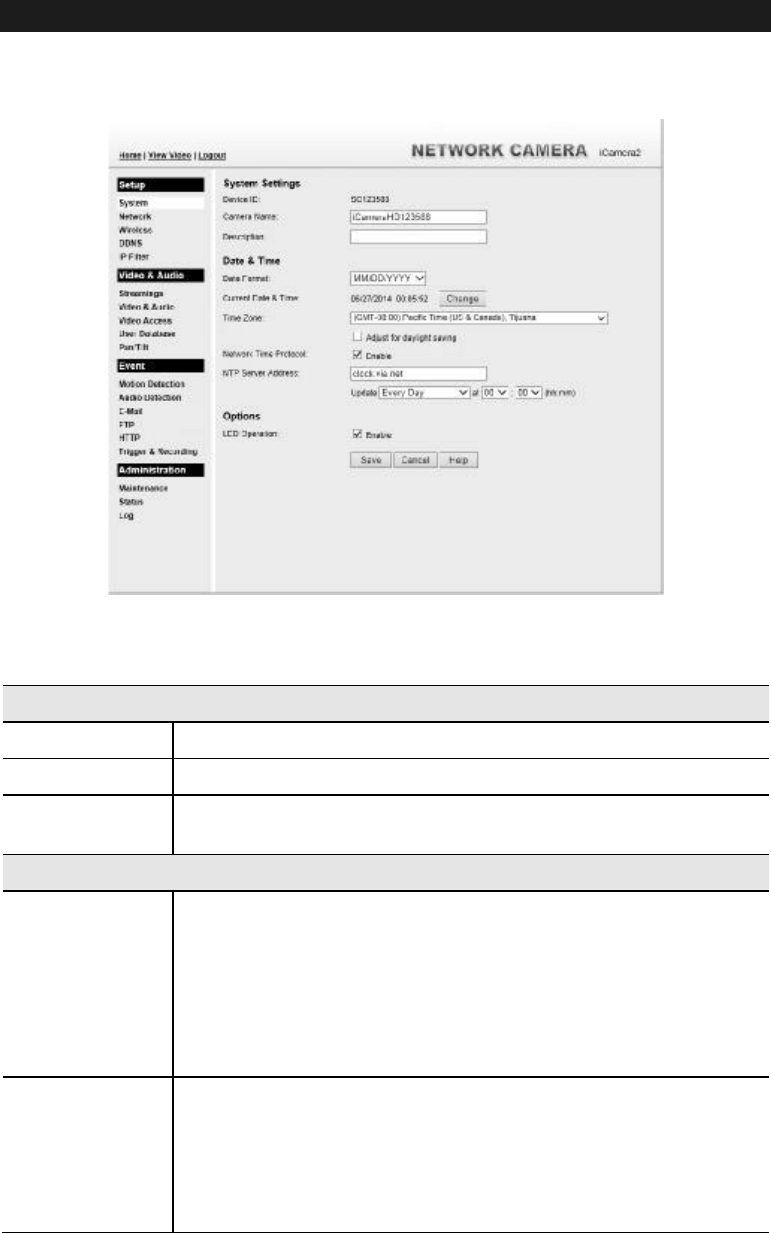
26
System Screen
After clicking Administration on the main menu, or selecting System on the Administration
menu, you will see a screen like the example below.
Figure 14: System Screen
Data - System Screen
System Settings
Device ID This displays the ID for the iCamera2.
Camera Name Enter the desired name for the iCamera2.
Description This field is used for entering a description, such as the location of the
iCamera2.
Date & Time
Date Format Select the desired date format, it will also be used to display the date
and time as an overlay on the video image.
The abbreviations used to predefine the date formats are list as follows:
• YYYY-MM-DD = Year-Month-Day, e.g. 2006-01-31
• MM/DD/YYYY = Month/Day/Year, e.g. 01/31/2006
• DD/MM/YYYY = Day/Month/Year, e.g. 31/01/2006
Current
Date & Time This displays the current date and time on the camera.
If it's not correct, click the Change button to modify the date/time
settings. This button will open a sub-screen where you have 2 options:
• Set the camera's date and time to match your PC.
• Enter the correct date and time.

27
Time Zone Choose the Time Zone for your location from the drop-down list.
If your location is currently using Daylight Saving, please enable the
Adjust for daylight saving checkbox.
Network Time
Protocol Enable or disable the Time Server feature as required.
If Enabled, the iCamera2 will contact a Network Time Server at
regular intervals and update its internal timer.
NTP Server
Address Enter the address for the desired NTP server.
Update The Schedule determines how often the iCamera2 contacts the NTP
Server.
Select the desired options.
LED Operation Enable this if you want to use this function.
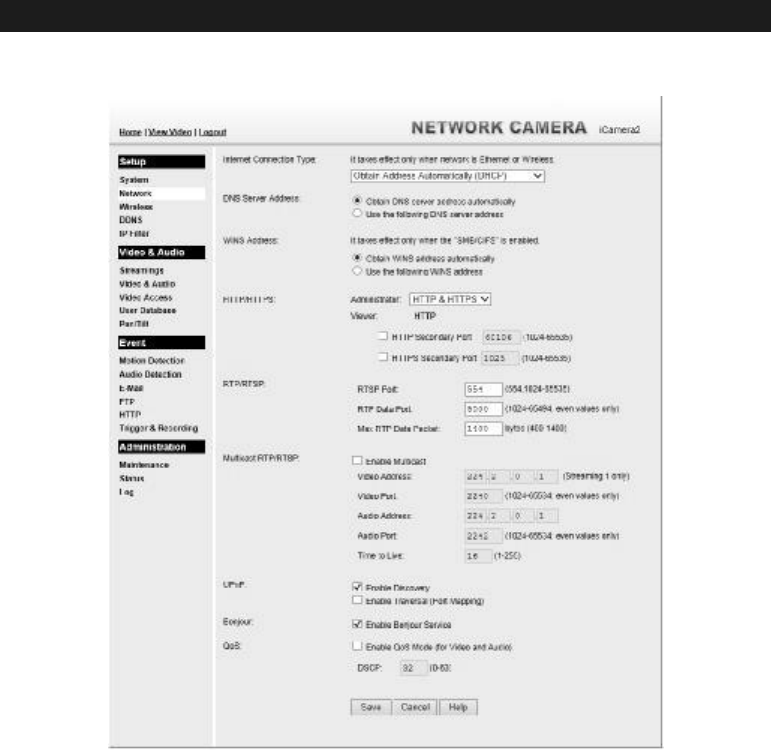
28
Network Screen
This screen is displayed when the Network option is clicked.
Figure 15: Network Screen

29
Data - Network Screen
Network
Internet Connection
Type There are 3 connection types:
• Obtain Address Automatically (DHCP): If selected, the
iCamera2 will obtain its IP address and related information
from a DHCP Server. Only select this option if your LAN has a
DHCP Server.
• Static IP Address: If selected, you must assign the following
data to the iCamera2.
• IP Address - Enter an unused IP address from the address
range used on your LAN.
• Subnet Mask - Use the same value as PCs on your LAN.
• Default Gateway - Use the same value as PCs on your
LAN.
• PPPoE (PPP over Ethernet): This is the most common login
method, widely used with DSL modems. Normally, your ISP
will have provided some software to connect and login. This
software is no longer required, and should not be used.
• Username - The user name (or account name) provided by
your ISP.
• Password - Enter the password for the login name above.
Obtain DNS server
address
automatically
If selected, the iCamera2 will use the DNS address or addresses
provided by the DHPC server.
This option is only available if the IP address setting is Obtain an
IP address Automatically.
Use the following
DNS server address Primary DNS server - Use the same value as PCs on your LAN.
Normally, your ISP will provide this address.
Secondary DNS server - This is optional. If entered, this DNS will
be used if the Primary DNS does not respond.

30
HTTP/HTTPS This sets the port number for HTTP/HTTPS connections to the
Camera, whether for administration or viewing video.
The HTTP (HyperText Transfer Protocol) is used for the standard
of transferring files (text, graphic images and other multimedia
files) on the World Wide Web. The default HTTP port is 60106.
HTTPS (Hypertext Transfer Protocol Secure) can provide more
secure communication with the SSL/TLS protocol, which support
data encryption to HTTP clients and servers. The default HTTPS
port is 1025.
The Secondary port can be used for other service and when more
than 2 cameras are in use.
If enabled, you can connect using either port 80 or the Secondary
port. You must enter the Secondary port number (between 1024 to
65535) in the field provided.
Note that when using a port number which is not 80, you must
specify the port number in the URL. For example, if the Camera's
IP address was 192.168.1.100 and the Secondary port was 1024,
you would specify the URL for the Camera as follows:
http://192.168.1.100:1024
RTP/RTSP The RTSP (Real Time Streaming Protocol), a standard for
connected client(s) to control streaming data (MPEG-4) over the
World Wide Web. Enter the RTSP Port number (between 1024 and
65535) in the field provided. The default RTSP Port is 554.
The RTP (Real Time Transport Protocol), an Internet protocol for
transmitting real-time data such as audio and video.
Max RTP Data Packet field will let users limit the size of the file.
Enter the desired value between 400 and 1400.
Note: RTSP and RTP settings are for cell phone only.
Multicast RTP/RTSP
Enable Multicast Enable the feature as required.
Video Address Enter the address of video (Streaming 1 only).
Video Port Enter the desired value (between 1024 to 65534) in the field
provided. The number you entered must be even values.
Audio Address Enter the address of the audio.
Audio Port Enter the desired value (between 1024 to 65534) in the field
provided. The number you entered must be even values.
Time to Live Enter the desired length of time, if the packets fail to be delivered
to their destination within. The Time to Live you entered must be
in-between 1 to 255.
UPnP
Enable Discovery If enabled, the iCamera2 will broadcast its availability through
UPnP. UPnP compatible systems such as Windows XP will then be
able to detect the presence of the iCamera2.

31
Enable Traversal If enabled, HTTP connections (from your Web Browser) can use
secondary port instead of port 80 (the standard HTTP port) to
access the camera.
Bonjour
Enable Bonjour
Service If enabled, the iCamera2 can be accessed through a "Bonjour"
enabled browser, such as Microsoft Internet Explorer (with a
Bonjour plug-in) or Safari browser. You can also find other
Bonjour-enabled devices on your network.
QoS
Enable QoS Mode If enabled, the throughput level (for Video and Audio) is
guaranteed through QoS (Quality of Service).
DSCP Enter the desired value of Differentiated Services Code Point
(DSCP). The value must be between 0 and 63.
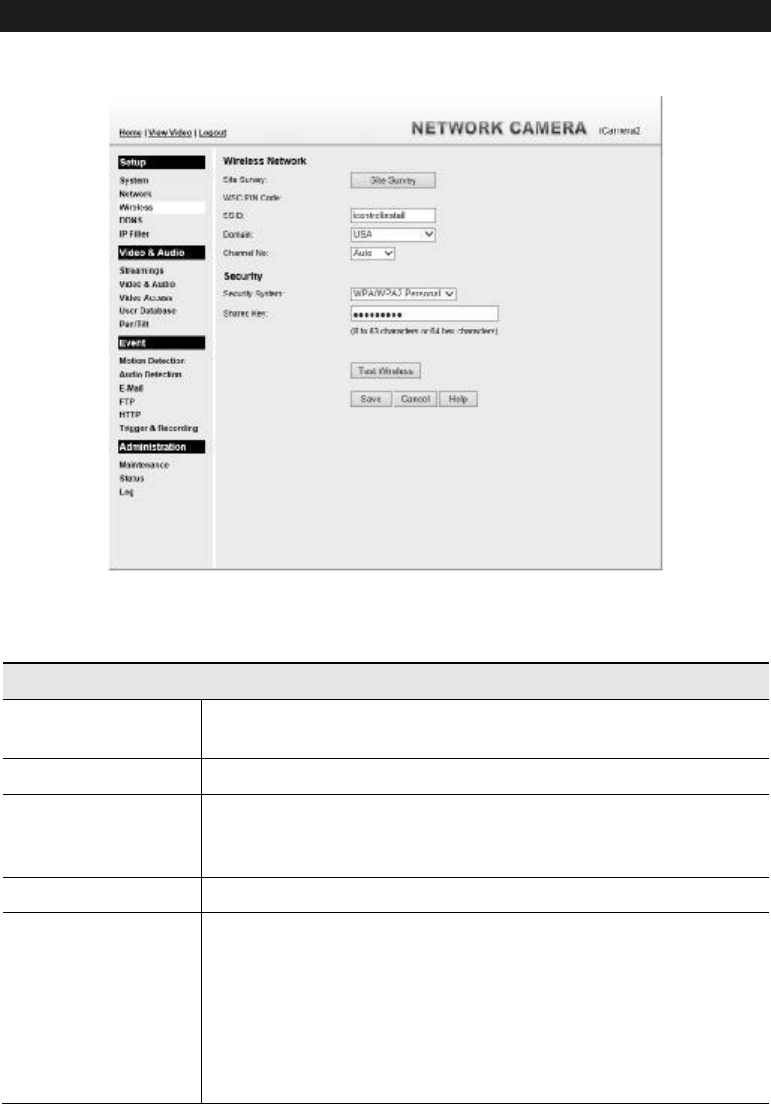
32
Wireless Screen
This screen is displayed when the Wireless menu option is clicked.
Figure 16: Wireless Screen
Data - Wireless Screen
Wireless Network
Site Survey Click the "Site Survey" button and select from a list of available
APs.
WSC PIN Code It displays the WSC PIN code number for the camera.
SSID This must match the value used by other devices on your wireless
LAN.
Note! The SSID is case sensitive.
Domain Select your region from the drop-down list.
Channel No. • In Infrastructure mode, this setting is ignored. The iCamera2
will use the Channel set on the Access Point.
• For Ad-hoc mode, select the Channel you wish to use on your
iCamera2. Other Wireless stations should use the same setting.
• If you experience interference (shown by lost connections
and/or slow data transfers) you may need to experiment with
different channels to see which one is the best.

33
Security
Security System Select the desired option, and then enter the settings for the selected
method:
• Disabled - No security is used. Anyone using the correct SSID
can connect to your network. This is default.
• WEP - The 802.11b standard. Data is encrypted before
transmission, but the encryption system is not very strong.
• WPA/WPA2 Personal - Like WEP, data is encrypted before
transmission. WPA is more secure than WEP, and should be
used if possible. WPA Personal is the version of WPA which
does NOT require a Radius Server on your LAN.
• WPA Personal (TKIP) - WPA has solved the WEP problems
with better encryption and authentication.
• WPA2 Personal (AES) - This is a further development of
WPA Personal, and offers even greater security.
WEP
Authentication Type
Normally this can be left at the default value of "Automatic." If that
fails, select the appropriate value - "Open System" or "Shared
Key." Check your wireless card's documentation to see what
method to use.
Note: In Infrastructure mode, either setting will normally work,
since most Access Points can use both methods.
WEP Encryption Select the WEP Encryption level:
• 64 Bit Keys (10 Hex chars)
• 128 Bit Keys (26 Hex chars)
• 64 Bit Keys (5 ASCII chars)
• 128 Bit Keys (13 ASCII chars)
Passphrase Enter a word or group of printable characters in the Passphrase box
and click the "Generate Key" button to automatically configure the
WEP Key(s). If encryption strength is set to 64-bit, then each of the
four key fields will be populated with key values. If encryption
strength is set to 128-bit, then only the selected WEP key field will
be given a key value.
WEP Keys
•
Use the radio buttons to select the default key.
• Enter the key value you wish to use. Other stations must have
the same key values.
• Keys must be entered in Hex. Hex characters are the digits (0 ~
9) and the letters A ~ F.
• Click Clear Keys to set the Keys to be blank.
Test Wireless
Click this button to test the wireless connection.
WPA/WPA2 Personal
Shared Key Enter the key value. Data is encrypted using a key derived from the
network key. Other Wireless Stations must use the same network
key. The PSK must be from 8 to 63 characters or 64 hex characters
in length.

34
WPA Personal
Shared Key Enter the key value. Data is encrypted using a key derived from the
network key. Other Wireless Stations must use the same network
key. The PSK must be from 8 to 63 characters or 64 hex characters
in length.
WPA2 Personal
Shared Key Enter the key value. Data is encrypted using a key derived from the
network key. Other Wireless Stations must use the same network
key. The PSK must be from 8 to 63 characters or 64 hex characters
in length.
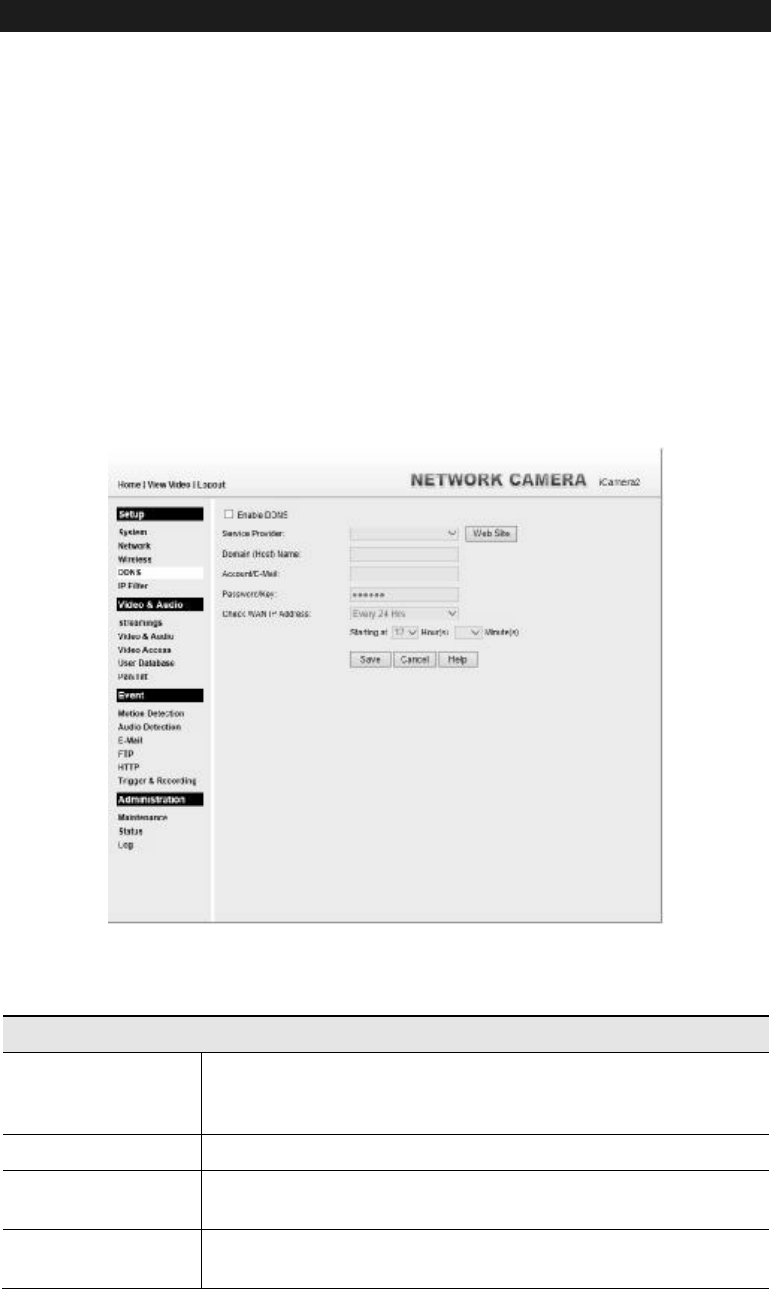
35
DDNS Screen
Many Internet connections use a "Dynamic IP address", where the Internet IP address is
allocated whenever the Internet connection is established.
This means that other Internet users don't know the IP address, so can't establish a connection.
DDNS is designed to solve this problem, as follows:
• You must register for the DDNS service with a DDNS service provider. The DDNS
Service provider will allocate a Domain Name to you upon request.
• The DDNS settings on the DDNS screen above must be correct.
• The Full HD IP Camera will then contact the DDNS server whenever it detects that the
Internet IP address has changed, and inform the DDNS server of the new IP address. (The
Check WAN IP Address determines how often the Full HD IP Camera checks if the
Internet IP address has changed.)
This system allows other internet users to connect to you using the Domain Name allocated by
the DDNS service provider.
This screen is displayed when the DDNS menu option is clicked.
Figure 17: DDNS Screen
Data - DDNS Screen
DDNS
Enable DDNS Enable or disable the DDNS function, as required.
Only enable this feature if you have registered for the DDNS
Service with a DDNS Server provider.
Service Provider Choose a service provider from the list.
Web Site Button Click this button to open a new window and connect to the Web
site for the selected DDNS service provider.
Domain (Host)
Name Enter the Domain Name (Host Name) allocated to you by the
DDNS Server provider.

36
Account/E-Mail Enter the login name for the DDNS account.
Password/Key Enter the password for the DDNS account.
Check WAN IP
Address Set the schedule for checking if the Internet IP address has
changed. If the IP address has changed, the DDNS Server will be
notified.
NOTE: If the DDNS Service provided some software to perform
this IP address update or notification, you should NOT use this
software. The update is performed by the camera.
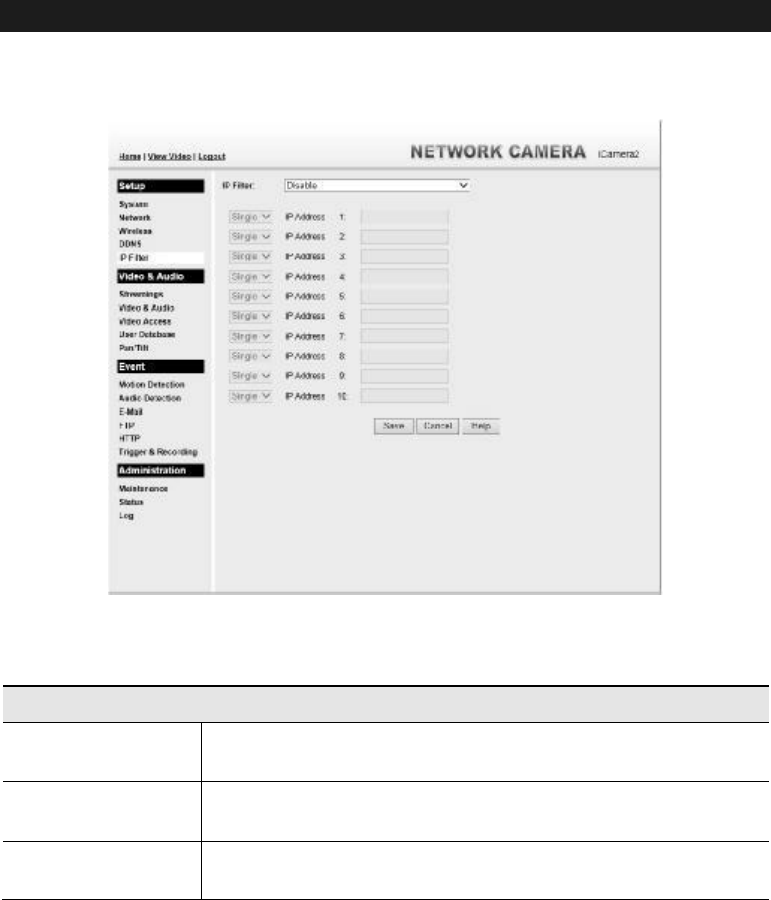
37
IP Filter
The IP Filter feature allows administrator to control Full HD IP Camera access by filtering IP
addresses. This screen is displayed when the IP Filter menu option is clicked.
Figure 18: IP Filter Screen
Data - IP Filter Screen
IP Filter
IP Filter Select the desired method to perform the IP address (or addresses)
filtering function.
Single/Range Select to perform either single IP address or a range of IP addresses
that you desired.
IP Address Enter an IP address or a range of IP addresses you would like to
allow or deny.
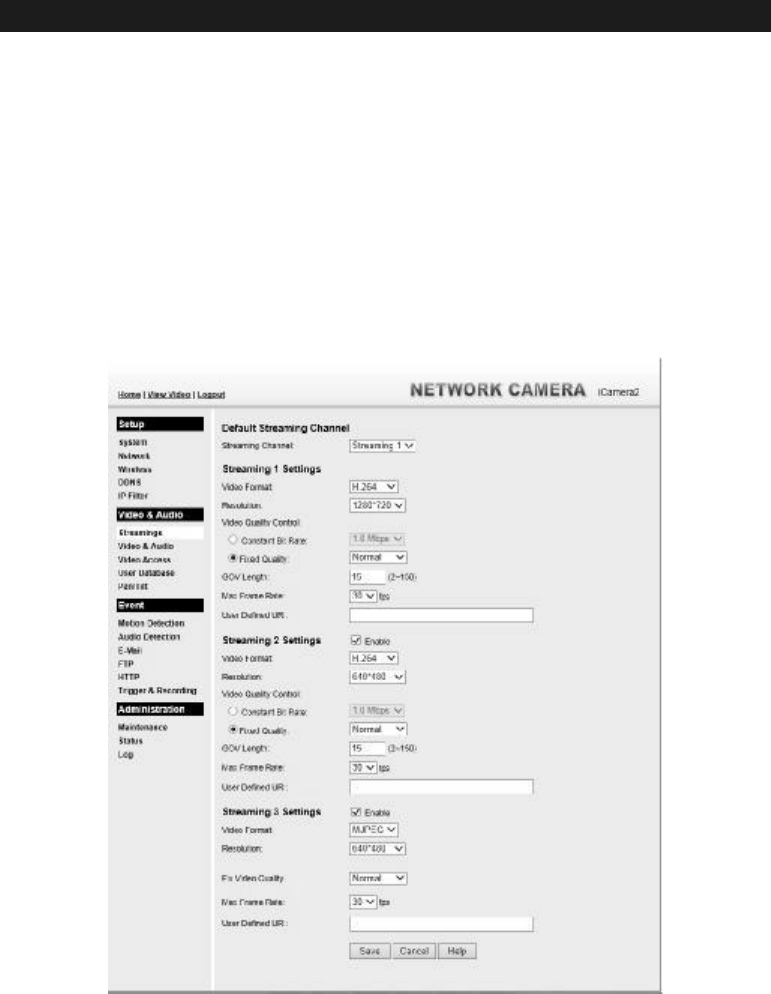
38
Streamings
This screen is displayed when the Streamings menu option is clicked.
If you want to view streaming via the cell phone:
1. Cell phone should be supported by 3GPP protocol.
2. Enter 554 for RTSP port number in the Network screen.
3. The H.264 format support cell phone option.
4. Enter the following address in the URI:
RTSP:// Router IP address / User Defined URI
5. Select 15 fps for Max Frame Rate.
Note! Due to the bandwidth limitation for the cell phone usage, please set the resolution,
quality and frame rate to lower values.
Figure 19: Streamings Screen

39
Data - Streamings Screen
Default Streaming
Channel Select the default channel for streaming from the drop-down list.
Streaming 1 Settings
Video Format Select the desired format from the list.
Resolution Select the desired video resolution format.
Video Quality
Control
•
Constant Bit Rate: Select the desired bit rate. The default is set
to 2.0 Mbps.
• Fixed Quality: Select the desired option. The default fix quality
is set to Normal.
Fixed Video
Quality There are five options:
• Very Low
• Low
• Normal
• High
• Very High
GOV Length Adjust the GOV interval in frame base. "2" means 1 I frame and 1 P
Frame. "3" means 1 I frame and 2 P Frames. Enter the desired value
between 2 and 150.
Max. Frame Rate Select the desired Maximum frame rate for the video stream.
The default value is 30.
User Defined URI You may enter the URI up to 32 characters long for accessing the
live video from camera through cell phone connection.
Streaming 2/3 Settings
Enable Check the box if you want to enable the streaming.
Video Format Select the desired format from the list.
Resolution Select the desired video resolution format.
Video Quality
Control
•
Constant Bit Rate: Select the desired bit rate. The default is set
to 1.0 Mbps.
• Fixed Quality: Select the desired option. The default fix quality
is set to Normal.
Fixed Video
Quality There are five options:
• Very Low
• Low
• Normal
• High
• Very High
GOV Length Adjust the GOV interval in frame base. "2" means 1 I frame and 1 P
Frame. "3" means 1 I frame and 2 P Frames. Enter the desired value
between 2 and 150.
Max. Frame Rate Select the desired Maximum frame rate for the video stream.
The default value is 20.

40
User Defined URI You may enter the URI up to 32 characters long for accessing the
live video from camera through cell phone connection.
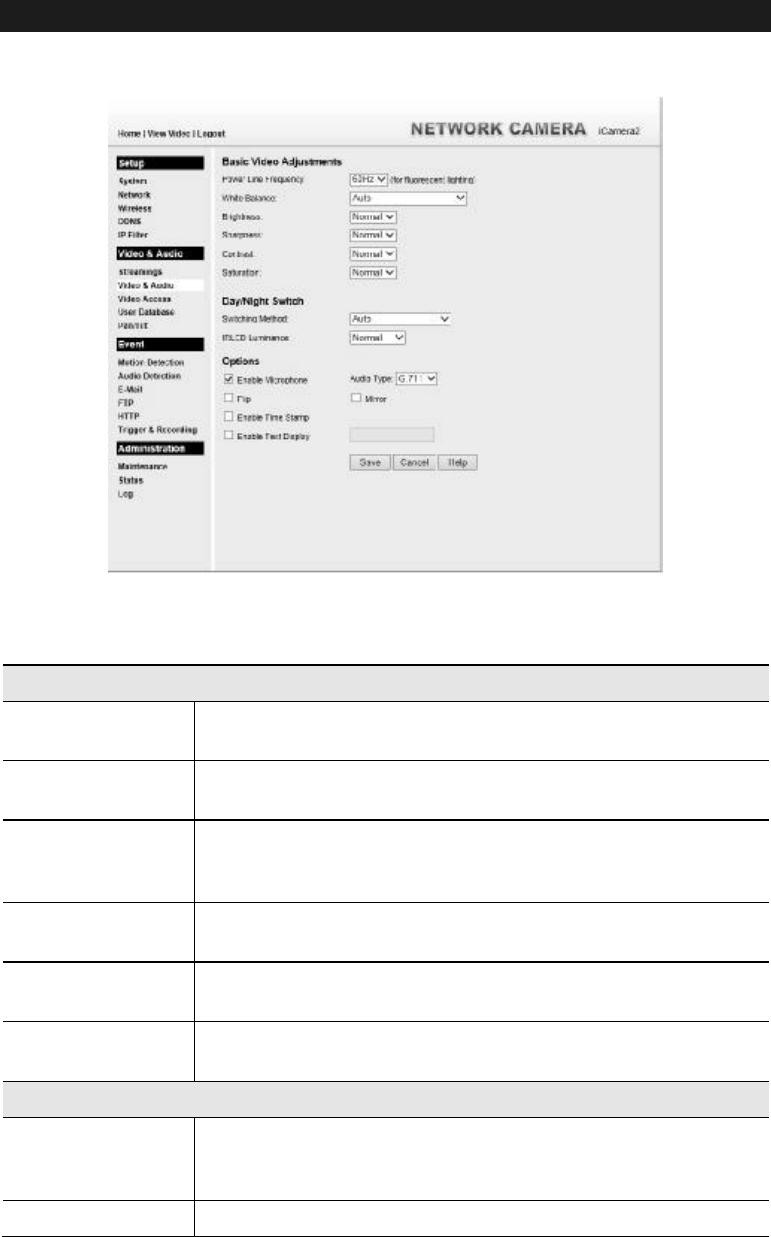
41
Video & Audio Screen
This screen is displayed when the Video & Audio menu option is clicked.
Figure 20: Video & Audio Screen
Data - Video & Audio Screen
Basic Video Adjustment
Power Line
Frequency Select the power line frequency (50Hz or 60Hz) used in your region,
to improve the picture quality under florescent lighting.
White Balance Select the desired option to match the current environment and
lighting.
Brightness If necessary, you can adjust the brightness to obtain a better image.
For example, if the camera is facing a bright light, the image may be
too dark. In this case, you can increase the brightness.
Sharpness Select the desired option for the sharpness. You can select a
Sharpness value between -3 and 3.
Contrast Select the desired option for the Contrast. You can select a value
between -3 and 3.
Saturation Select the desired option for the Saturation. You can select a value
between -3 and 3.
Day/Night Switch
Switching Method The iCamera2 supports Day/Night mode switch for getting better
quality of the low light condition. Select the desired method to use
this function.
IRLED Luminance
Select the desired lightness for the IR LED.

42
Options
Enable Microphone
Enable audio by checking this checkbox. Using Audio will increase
the bandwidth requirements slightly.
Audio Type Select the desired audio type.
Flip This setting will have the image swapped top-to-bottom.
Mirror This setting will have the image swapped left-to-right.
Enable Time Stamp
If enabled, the current time will be displayed on the Video image.
Enable Text
Display Enable this setting if you want text to be displayed on the Video
image, and enter the desired text - up to 20 characters. This feature
is often used to identify each camera when multiple cameras are
installed.
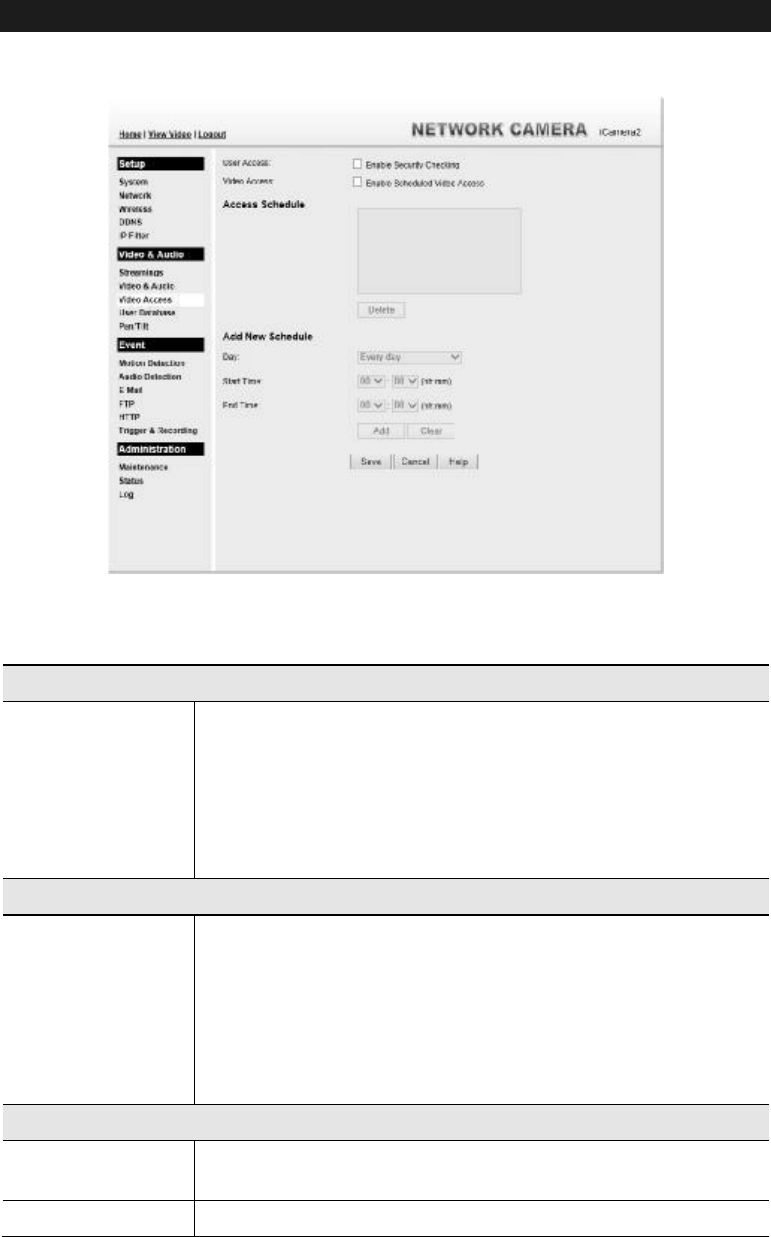
43
Video Access Screen
This screen is displayed when the Video Access option is clicked.
Figure 21: Video Access Screen
Data - Video Access Screen
User Access
Enable Security
Checking
•
If disabled (default) - No login required. Users do not have to
provide a username and password when they connect to the
camera for viewing video.
• If enabled - Require login. Users will be prompted for a
username and password when they connect to the camera for
viewing video. The camera administrator must use the "User
Database" menu option to create the desired users.
Video Access
Enable Scheduled
Video Access
•
If enabled - Viewing video is available during the scheduled
periods and unavailable at other times. If this option is selected,
you need to define a schedule. If no schedule is defined, this
option is always disabled.
• If disabled - The option will remain disabled until you enable it.
Note that regardless of which setting is chosen, the Administrator
can ALWAYS access the camera and view live video.
Access Schedule
Scheduled Periods This displays all periods you have entered into the database. If you
have not entered any periods, this list will be empty.
Delete Use the Delete button to delete the selected item in the list.

44
Add New Schedule
Day Choose the desired option for the period.
Start Time Enter the start time using a 24 hr clock.
End Time Enter the end time using a 24 hr clock.
Add Click this button to add a new period.
Clear Use this button to clear the input fields.
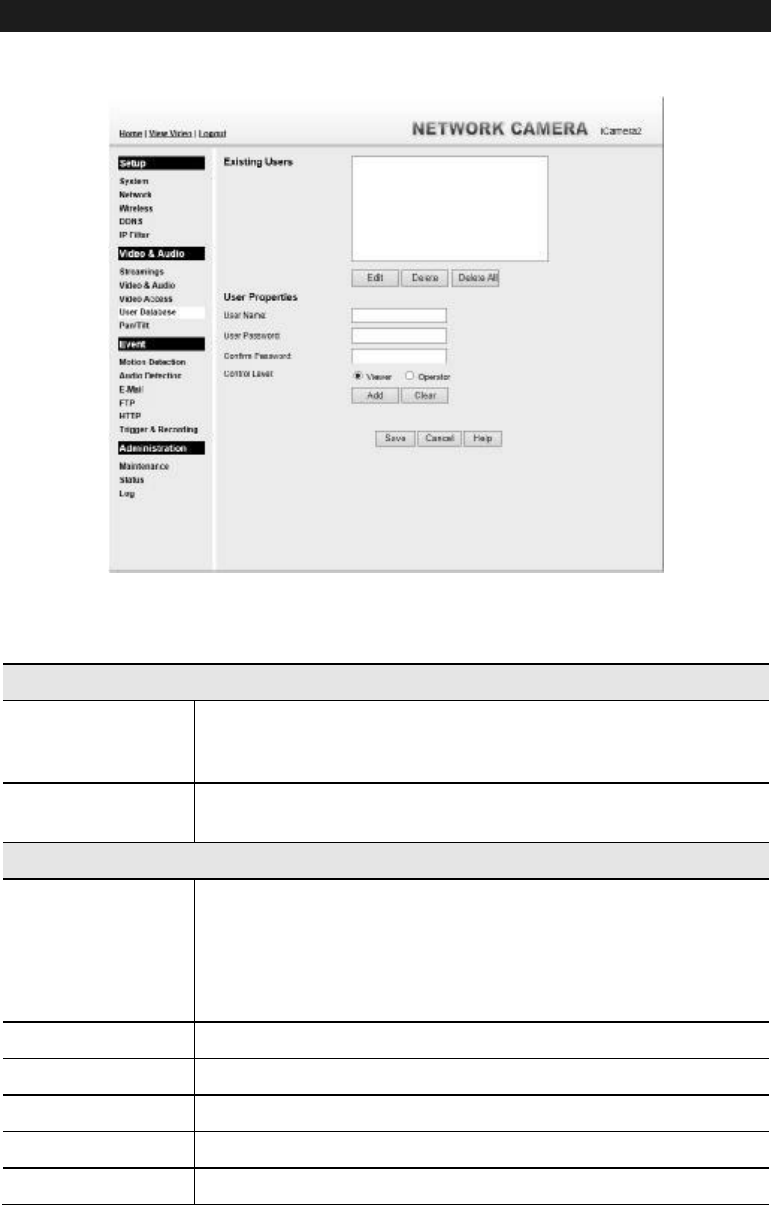
45
User Database Screen
This screen is displayed when the User Database option is clicked.
Figure 22: User Database Screen
Data - User Database Screen
Existing Users
User List This displays all users you have entered into the User database. If
you have not entered any users, this list will be empty.
The maximum number of users is 20.
Edit, Delete, Delete
All Use these buttons to manage the user database.
User Properties
User Name Enter the name for the user here.
• Spaces, punctuation, and special characters must NOT be used
in the name.
• The name is case insensitive (case is ignored), so you can not
have 2 names which differ only by case.
User Password The password for this user.
Confirm Password Re-enter the password for the user, to ensure it is correct.
Control Level Select either Viewer or Operator for the user you plan to add.
Add Button Click this button to add a new user, using the data shown on screen.
Clear Button Use this button to clear the input fields, ready to add a new user.
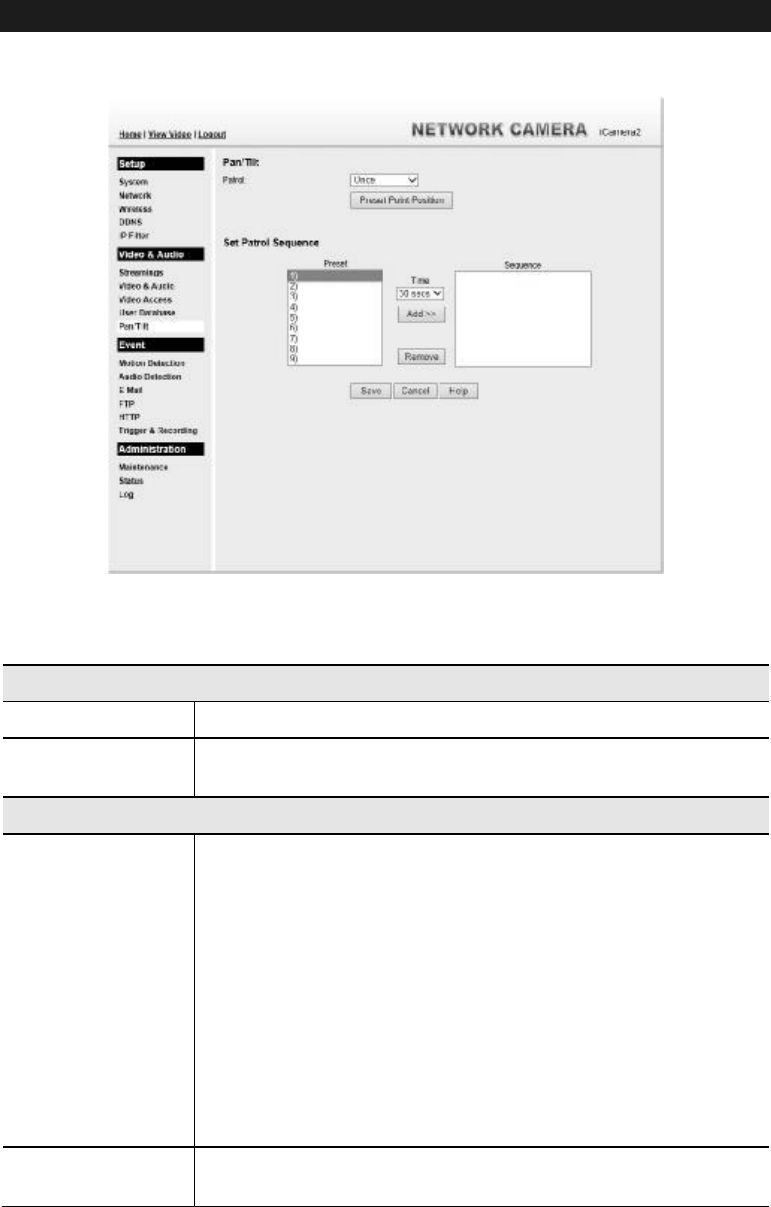
46
Pan/Tilt Screen
This screen is displayed when the Pan/Tilt option on the Video & Audio menu is clicked.
Figure 23: Pan/Tilt Screen
Data - Pan/Tilt Screen
Pan/Tilt
Patrol Select desired option for the patrol function.
Preset Point
Position Click this button to define the preset point position.
Set Patrol Sequence
Set Patrol Sequence
This feature determines how the camera will move when it is set to
either "Once" or "Always" rotate. You can set a number of Preset
Positions; the camera will go to the first position, then move through
the list of present positions until it is finished. The camera will stop
at the last position in the list.
To create the Preset Sequence, select the desired Preset Position in
the left column, and click the "Add >>" button. Repeat until the
desired sequence is complete. Note that you can add the same Preset
Position more than once; this can be used to make the camera stay
longer at one position.
To delete a position from the Sequence, select the desired position
and click the "Remove" button.
Time This determines how long the camera will stay at each position
while executing the sequence. Set this to the desired value.
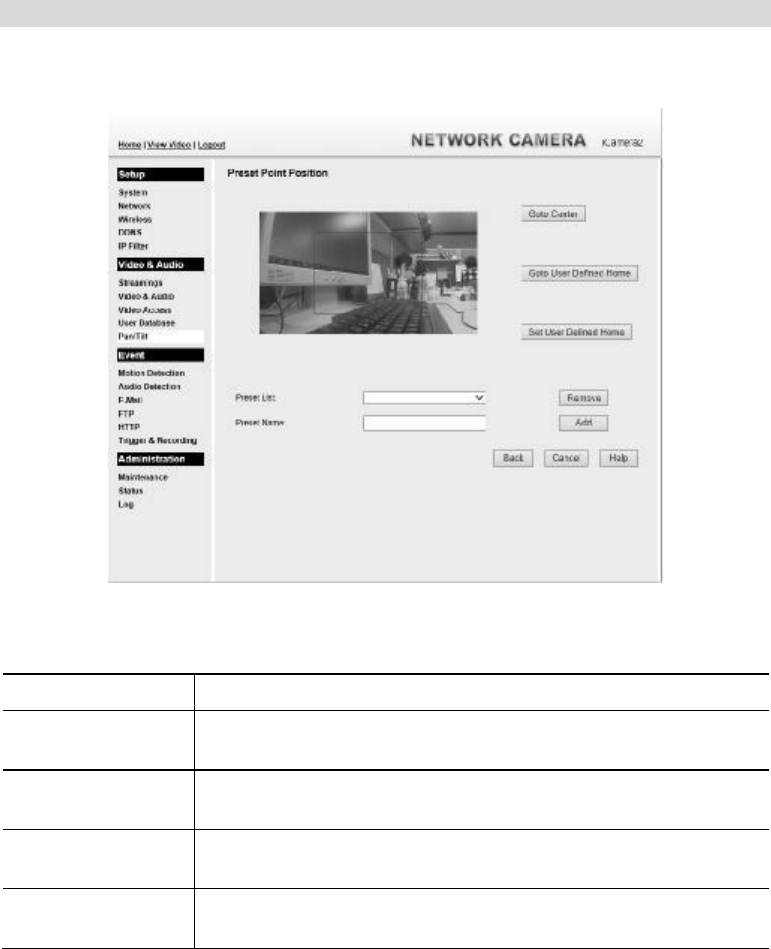
47
Set Preset Position Screen
This screen is displayed when the Preset Point Position button on the Pan/Tilt screen is
clicked.
Figure 24: Preset Point Position Screen
Data - Preset Point Position
Goto Center Click this button to go to the center location.
Goto User Defined
Home Go to the user defined location.
Set User Defined
Home Set the calibration to the user defined location.
Preset List Select the desired Preset. The screen will update with the current
data for the selected Preset Position.
Preset Name Enter a suitable name for the Preset Position.
If no name is entered, the preset will have a number only.
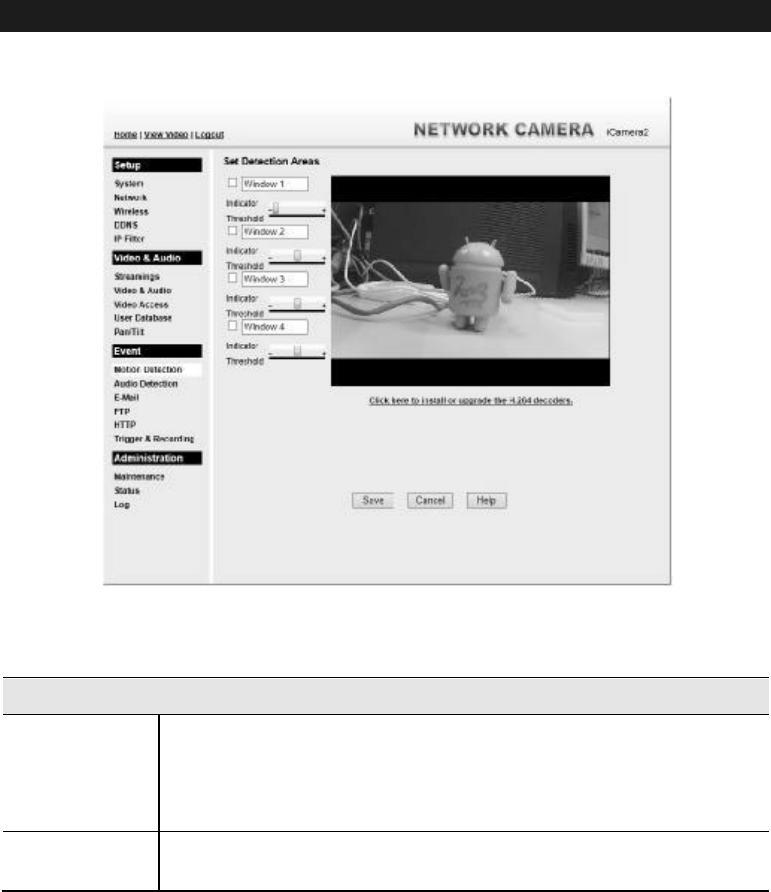
48
Motion Detection Screen
This screen is displayed when the Motion Detection option on the Event menu is clicked.
Figure 25: Motion Detection Screen
Data - Motion Detection Screen
Motion Detection
Motion Enable Enable this if you want to use motion detection.
Note: Motion detection can be triggered by rapid changes in lighting
condition, as well as by moving objects. For this reason, it should only
be used indoors.
Indicator/
Threshold Administrator needs to adjust the relation between indicator and
threshold for each area.
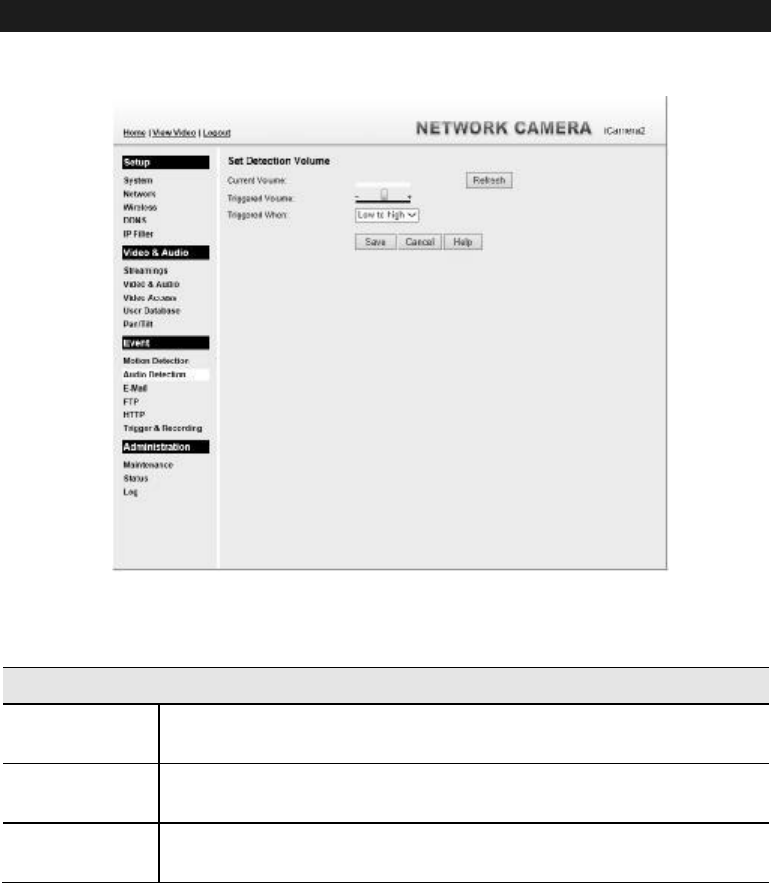
49
Audio Detection Screen
This screen is displayed when the Audio Detection option on the Event menu is clicked.
.
Figure 26: Audio Detection Screen
Data - Audio Detection Screen
Audio Detection
Current
Volume It displays the current volume of the environment. Click Refresh to
update the status.
Triggered
Volume Drag the bar to set the volume for triggering.
Triggered
When Choose the desired situation for triggering the audio detection.
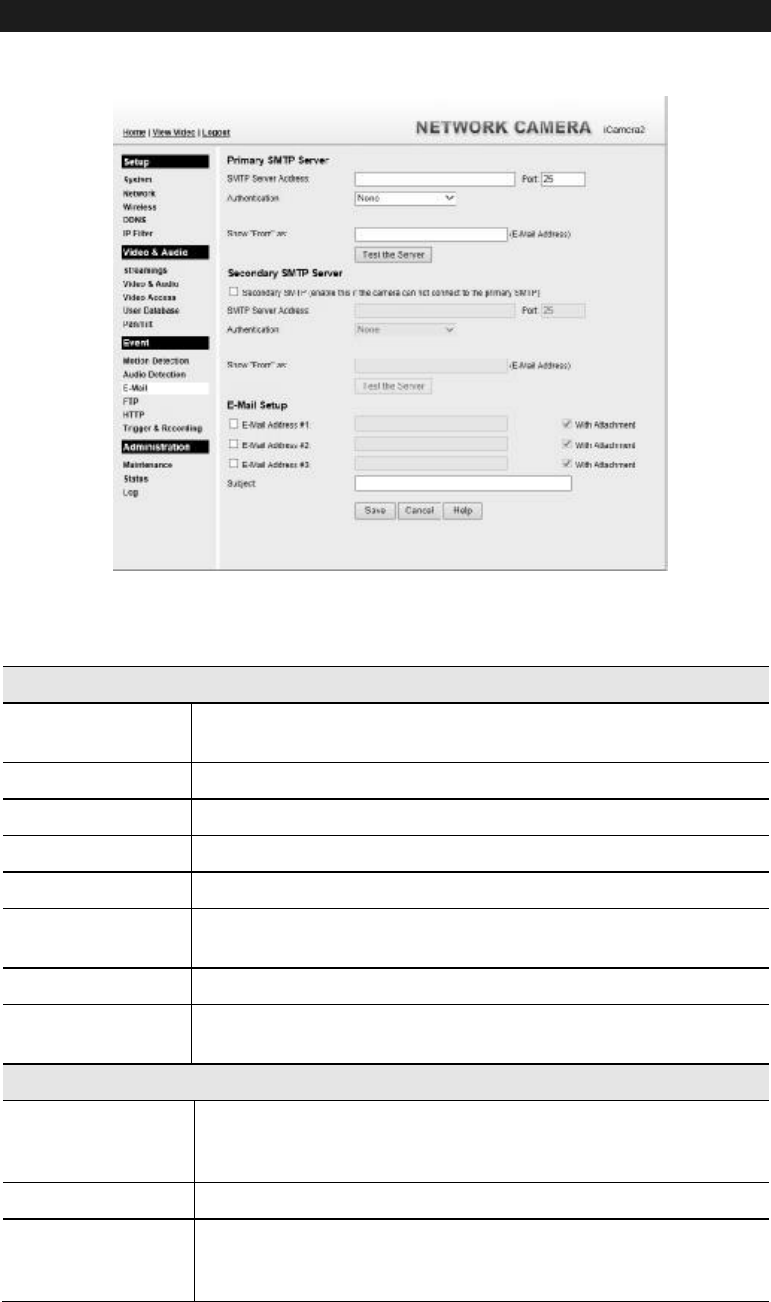
50
E-Mail Screen
This screen is displayed when the E-Mail option on the Event menu is clicked.
.
Figure 27: E-Mail Screen
Data - E-Mail Screen
Primary/Secondary SMTP Server
SMTP Server
Address Enter the address of the SMTP (Simple Mail Transport Protocol)
Server to be used to send E-Mail.
Authentication Select the desired Authentication type for the SMTP Server.
SMTP Login name
Enter your login name for the SMTP Server.
SMTP Password Enter your password for the SMTP Server.
POP server name Enter the name for the POP Server.
Show "From" as Enter the E-Mail address to be shown in the "From" field when the
E-Mail is received.
Test the Server Click this button to test the server connection.
Secondary SMTP Check the box to upload to the Secondary SMTP if the camera can
not connect to the primary SMTP.
E-Mail Setup
E-mail Address Enter at least one (1) E-Mail address; the 2nd and 3rd addresses are
optional. The E-Mail alert will be sent to the E-Mail address or
addresses specified here.
With Attachment Enable the checkbox if you want to attaché files to the E-mail.
Subject Enter the desired text to be shown as the "Subject" for the E-Mail
when it is received. Subject can not exceed 48 alphanumeric
characters.
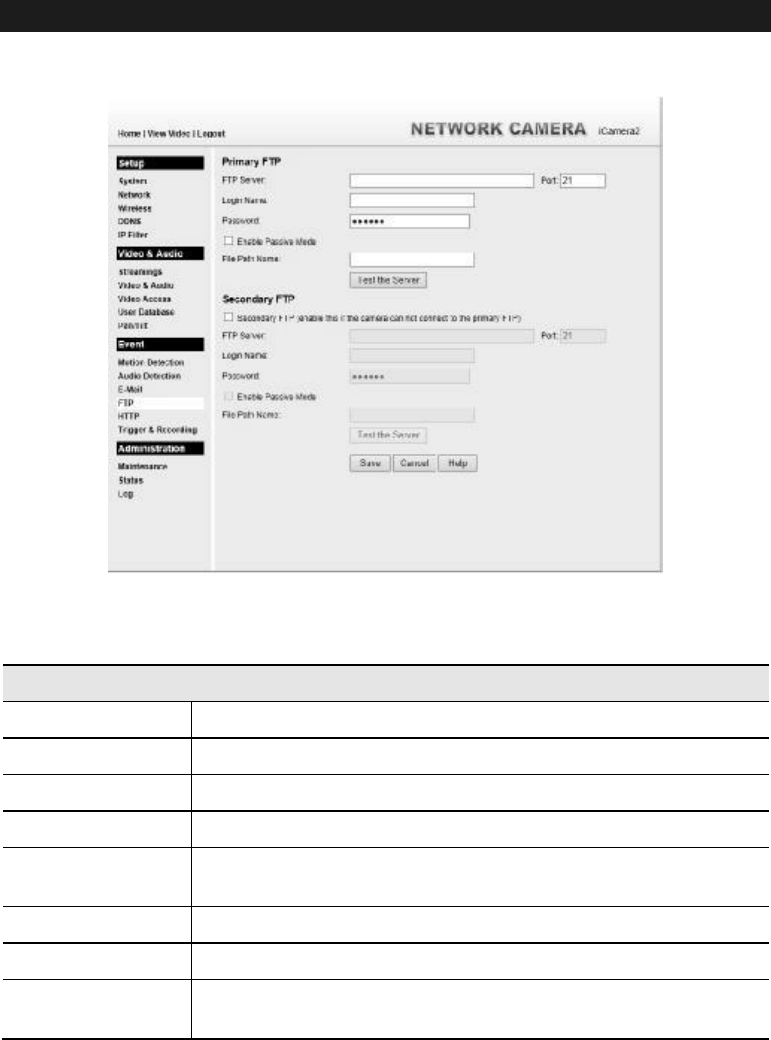
51
FTP Screen
This screen is displayed when the FTP option on the Event menu is clicked.
Figure 28: FTP Screen
Data - FTP Screen
Primary/Secondary FTP
FTP Server Enter the address of the FTP Server.
Port Enter the Port of the FTP Server to be connected.
Login name Enter your login name for the FTP Server.
Password Enter your password for the FTP Server.
Enable Passive
Mode Check the box to enable the Passive mode feature of the FTP.
File Path Name Enter the file path/name of the FTP.
Test the Server Click this button to test the server connection.
Secondary FTP Check the box to upload to the Secondary FTP if the camera can not
connect to the primary FTP.
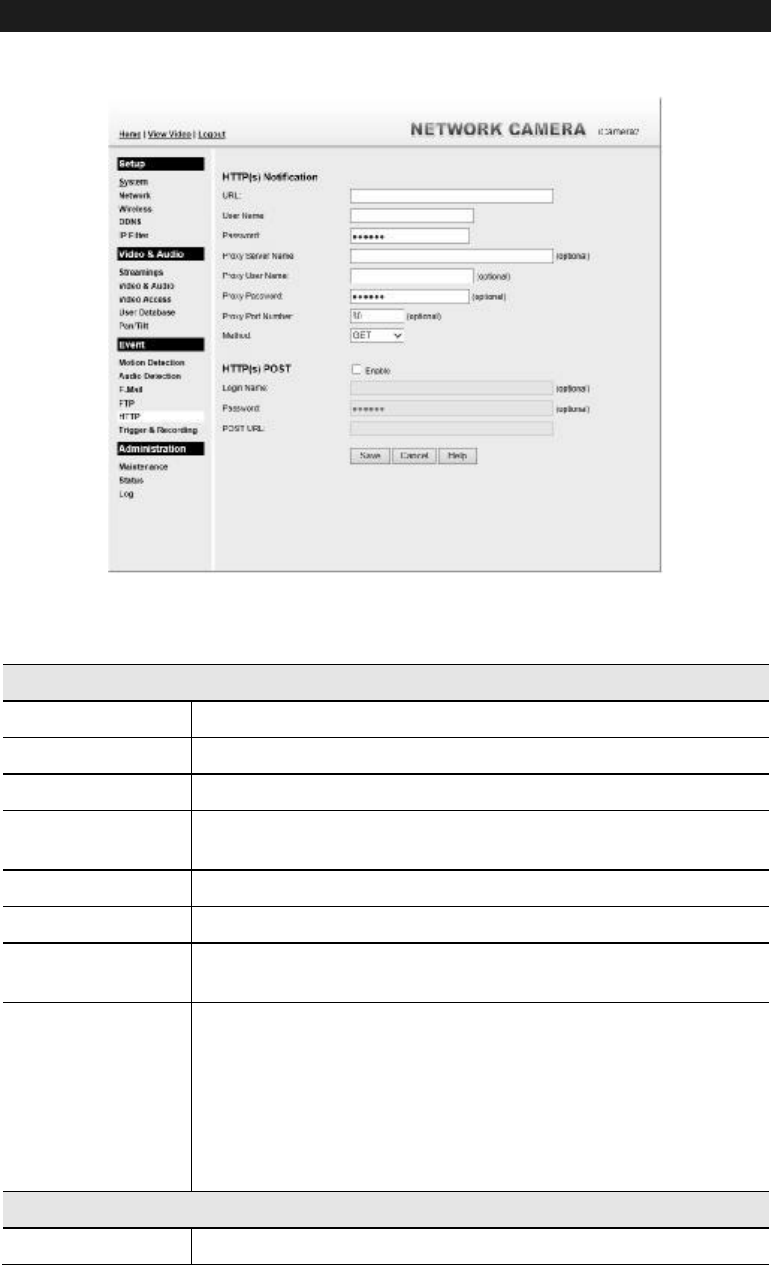
52
HTTP Screen
This screen is displayed when the HTTP option on the Event menu is clicked.
Figure 29: HTTP Screen
Data - HTTP Screen
HTTP(s) Notification
URL Enter the URL of your HTTP notification server.
User Name Enter the user name of your HTTP server.
Password Enter the password to match the user name above.
Proxy Server
Name Specify the proxy server name in the provided field if the camera
needs to pass through a Proxy Server to do the HTTP notification.
Proxy User Name Enter the user name for the proxy server.
Proxy Password Enter the password for the proxy server.
Proxy Port
Number Enter the port number for the proxy server.
Method Select the desired method of form data encoding.
• Get - It should be used if and only if the form processing is
independent, which typically means a pure query form.
Generally it is advisable to do so.
• Post - If there are problems related to long URLs and non-ASCII
character repertoires, which can make it necessary to use
"POST" even for independent processing.
HTTP(s) Post
Login Name Enter the login name of your HTTP post server.

53
Password Enter the password to match the user name above.
Post URL Enter the URL of your HTTP post server.
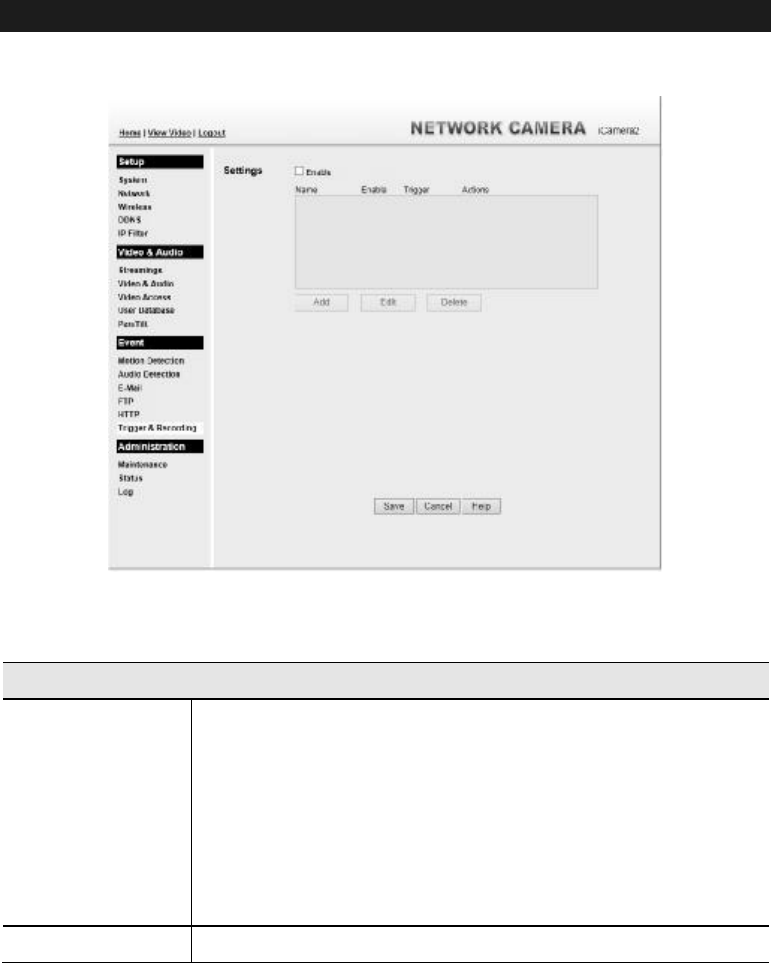
54
Trigger & Recording Screen
This screen is displayed when the Trigger & Recording option is clicked.
Figure 30: Trigger & Recording Screen
Data - Trigger & Recording Screen
Event Schedule
Schedule List The Event Schedule shows all of the event types currently
configured in the Waterproof HD IP Camera, along with various
information about their configuration, as listed below:
• Name - the descriptive event name set by the user.
• Enable - shows the event is enable or disable.
• Trigger - shows what kind trigger activate the event.
• Actions - shows what kind of the actions will be issued when the
event is triggered.
Add, Edit, Delete Use these buttons to manage the schedule list.
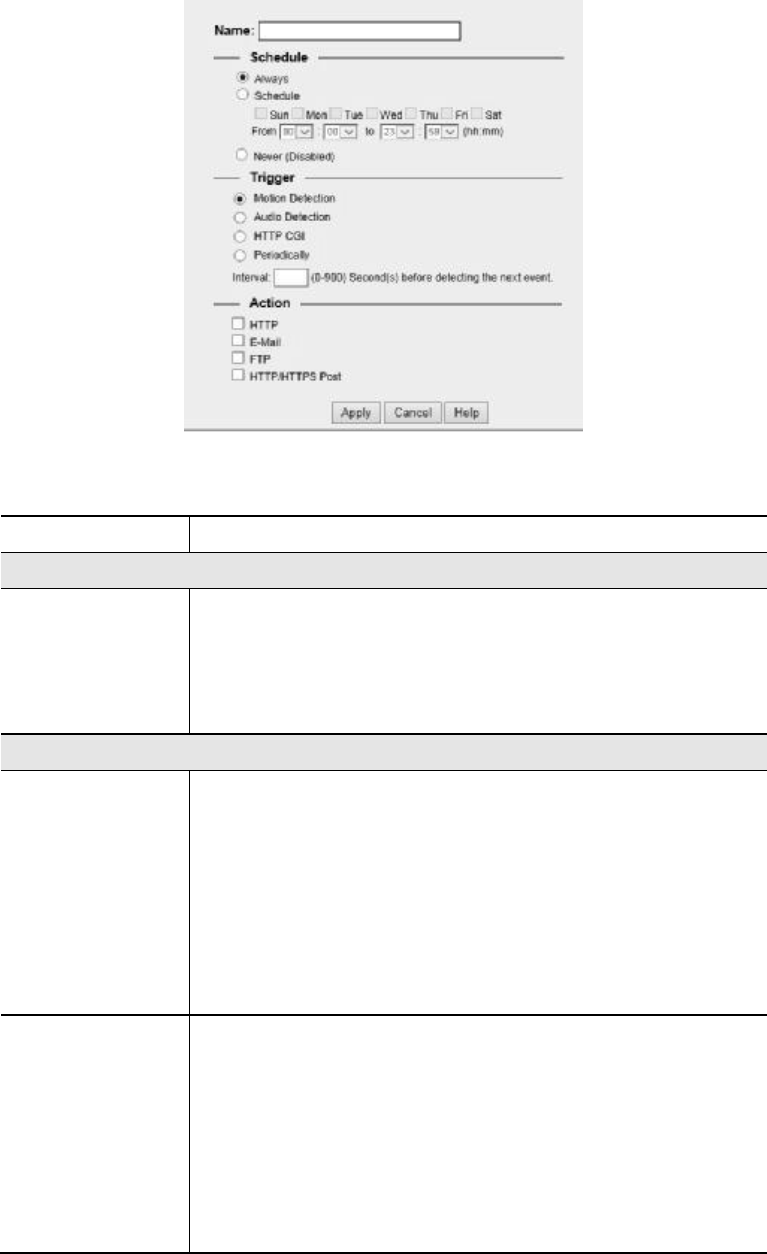
55
Add a new Schedule
Figure 31: Add schedule screen
Name Enter the name of the schedule.
Schedule
Schedule Choose the desired option:
• Always
• Schedule
• Never
Trigger Event
Trigger by
•
Motion Detection - Movement in a motion detection window
can be used to trigger events.
• Audio Detection - The sound detection can be used to trigger
events.
• HTTP Trigger- If checked, a HTTP CGI command will be
delivered to the HTTP server.
• Periodically - If checked, the events will be triggered at regular
intervals of time.
Interval - Select the desired interval from the list.
Actions
•
HTTP - If checked, a HTTP notification will be delivered to the
HTTP server.
• E-Mail - If checked, an E-Mail (with "Attachment") will be
delivered to the SMTP server. (SMTP Server must be
configured on the E-Mail page.)
• FTP - If checked, an FTP upload will be activated to the FTP
server. (FTP servers must be configured on the FTP page.)
• HTTP/HTTPS Post - If checked, a HTTP notification will be
delivered to the HTTP post server.

56
Attachment Type
•
Pre/Post Capture - Select the desired length. The size of the
file depends on this setting, and also the Video size and degree
of compression.
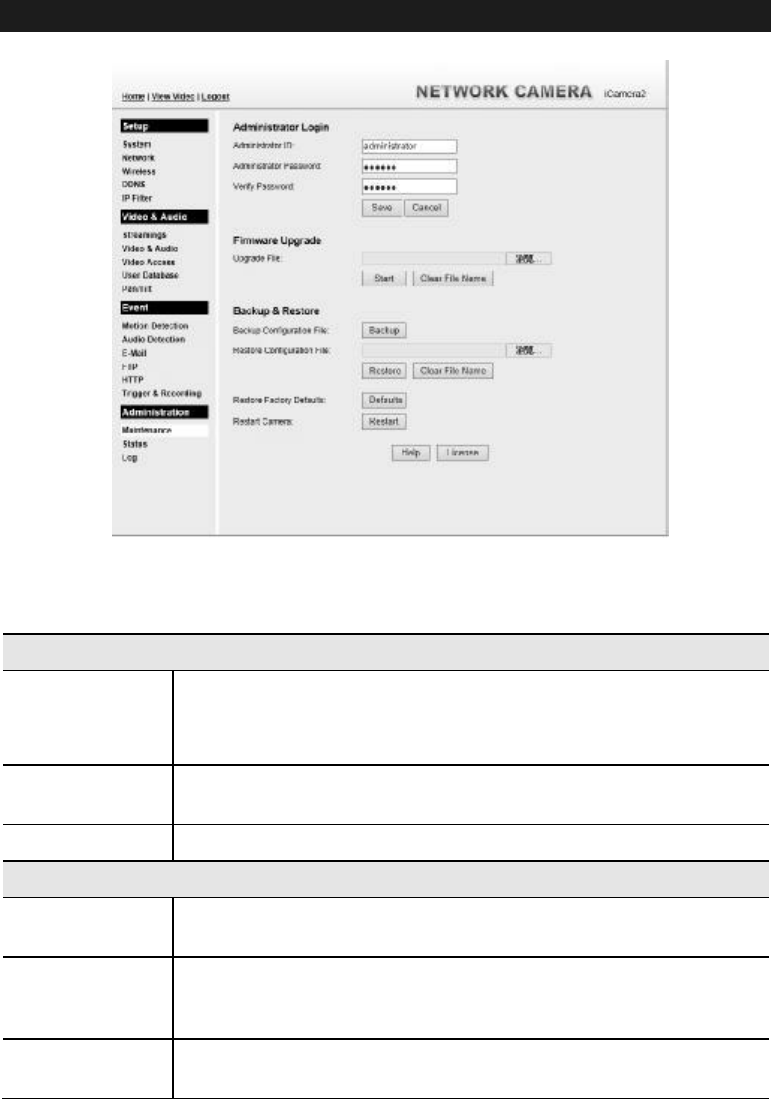
57
Maintenance Screen
.
Figure 32: Maintenance Screen
Data - Maintenance Screen
Administrator Login
Administrator
ID Enter the name for the Administrator here.
Spaces, punctuation, and special characters must NOT be used in the
name.
Administrator
Password The password for the Administrator.
Verify Password
Re-enter the password for the Administrator, to ensure it is correct.
Firmware Upgrade
Upgrade File Click the "Browse" button and browse to the location on your PC
where you stored the Firmware file. Select this file.
Start Click this button to start the Firmware. When the upgrade is finished,
the iCamera2 will restart, and this management connection will be
unavailable during the restart.
Clear File Name This does NOT stop the Upgrade process if it has started. It only clears
the input for the "Upgrade File" field.

58
Backup & Restore
Backup
Configuration
File
Click Backup button to save the current configuration information to a
text file.
It is suggested to backup the configuration file, in order to restore the
camera easily.
Restore
Configuration
File
Click Restore button to reinitialize the camera to load the new updated
software. Do this after loading the upgrade file.
Clear File Name This does NOT stop the Restore process if it has started. It only clears
the input for the "Restore Configuration File" field.
Restore Factory
Defaults Click Defaults button to reloads all default settings on the camera.
Restart Camera Click Restart button to restarts the camera.
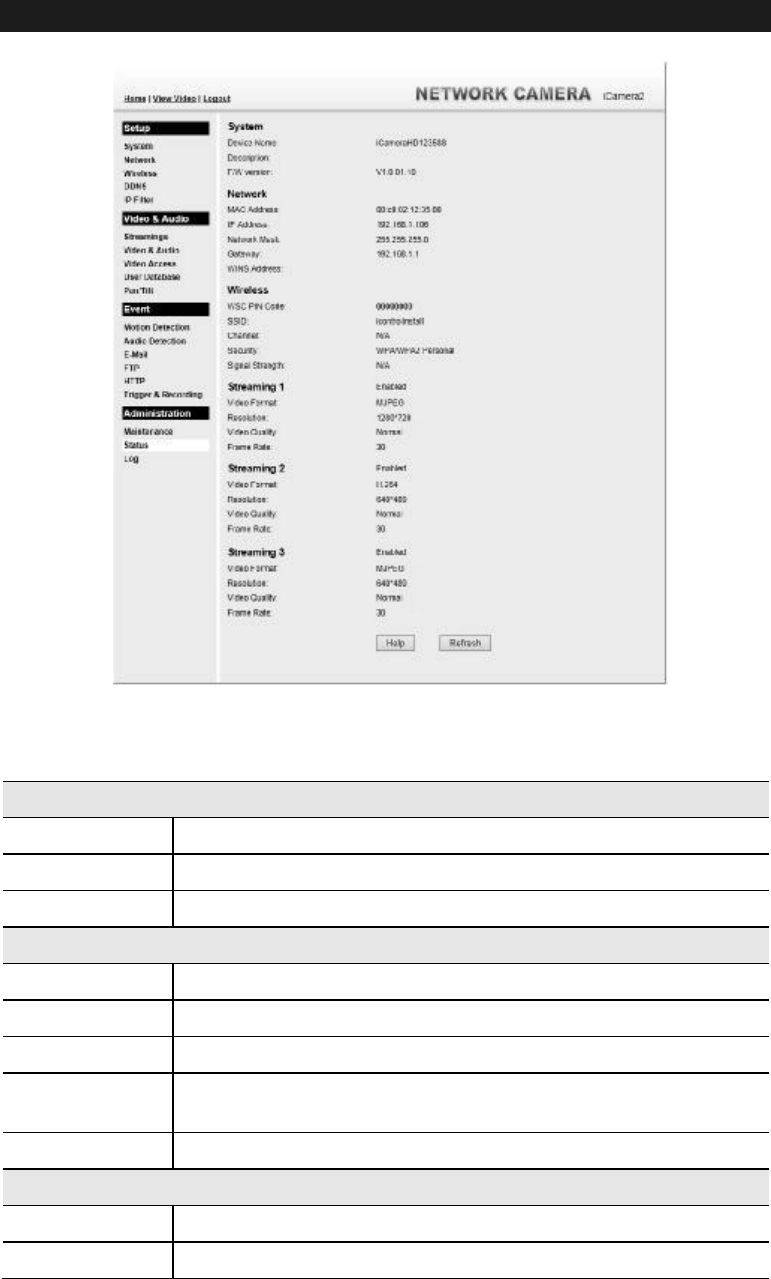
59
Status Screen
.
Figure 33: Status Screen
Data - Status Screen
System
Device Name This shows the name of the iCamera2.
Description This shows the description of the iCamera2, such as location.
F/W version The version of the current firmware installed.
Network
MAC Address The current IP address of the iCamera2.
IP Address The IP Address of the Network Camera.
Network Mask The network mask associated with the IP address above.
Gateway The IP Address of the remote Gateway associated with the IP Address
above.
WINS Address The IP Address of the WINS server.
Wireless
WSC PIN Code It displays the current WSC PIN code.
SSID This displays the wireless SSID.

60
Channel This shows the wireless channel currently used.
Security The current security setting for Wireless connections.
Signal Strength This shows the strength of the signal.
Streaming (1~3)
Video Format It displays the current format of video.
Resolution The image size of the video stream.
Video Quality This displays the image quality of the video stream.
Frame Rate This displays the frame rate of the video stream.
Buttons
Refresh Update the log and any other data on screen.
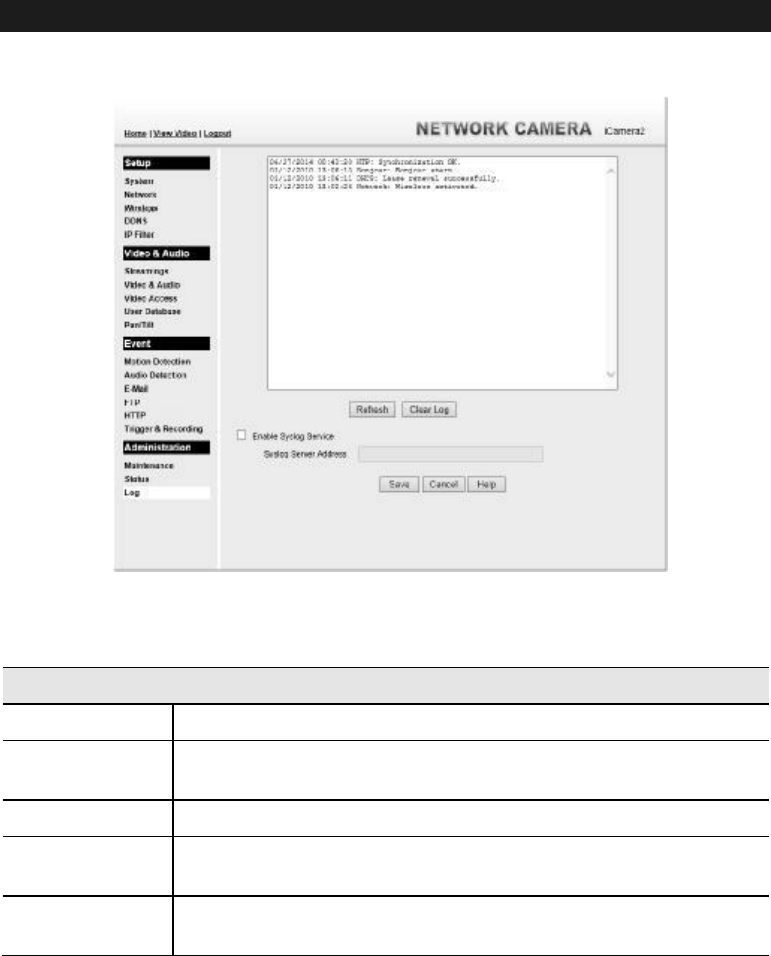
61
Log Screen
This screen displays a log of system activity.
.
Figure 34: Log Screen
Data - Log Screen
Log
System Log This is a log of system activity.
Refresh
Button Click this to update the data shown on screen.
Clear Log Click this button to restart the log.
Enable Syslog
Service Check the box to enable the System Log Server feature.
Syslog Server
Address Enter the address of the Syslog Server.

62
Chapter 7
Troubleshooting
This chapter covers the most likely problems and their solutions.
Overview
This chapter covers some common problems that may be encountered while using the
iCamera2 and some possible solutions to them. If you follow the suggested steps and the
iCamera2 still does not function properly, contact your dealer for further advice.
Problems
Problem 1: I can't connect to the iCamera2 with my Web Browser to configure it.
Solution 1: It is possible that your PC's IP address is not compatible with the IP
address of the iCamera2.
Problem 2 When I try to connect to the iCamera2, I get prompted for a user
name and password.
Solution 2 You SHOULD be prompted for a user name and password if trying to
access the Administration menu.
Enter the Administrator ID and Administrator Password set on the
Maintenance screen.
If you are just trying to view Video, the User Name/Password prompt
indicates that the Administrator has restricted access to specified users.
Ask the Administrator for your User Name and Password.
Problem 3 I can't connect to the iCamera2 using a Wireless connection.
Solution 3 1) If a LAN cable is connected to the LAN port, the Wireless interface is
disabled. Only one interface can be active.
2) Check that your PC and the iCamera2 have compatible Wireless
settings.
• Mode (Infrastructure or Ad-hoc) must be correct.
• ESSID must match.
• WEP settings must match.
• In Ad-hoc mode, the Channel should match, although this is often not
required.
Problem 4 Video quality may suddenly deteriorate.
Solution 4 This can happen when an additional viewer connects to the iCamera2,
overloading the camera or the available bandwidth. The image size and
quality can be adjusted to cater for the required number of viewers and the
available bandwidth.
7
63
Problem 5 The motion detection feature doesn't send me any E-mail.
Solution 5 It may be that the SMTP (Simple Mail Transport Protocol) server used by
the camera to send the E-Mail will not accept mail. (This is to prevent span
being sent from the server.). Try using a different SMTP server, or contact
your ISP to see if SMTP access is being blocked.
Problem 6 Using the motion detection feature, I receive E-Mails which don't show
any moving objects.
Solution 6 The motion detection feature doesn't actually detect motion. It compares
frames to see if they are different. Major differences between frames are
assumed to be caused by moving objects.
But the motion detector can also be triggered by:
• Sudden changes in the level of available light
• Movement of the camera itself.
Try to avoid these situations. The motion detection feature works best in
locations where there is good steady illumination, and the camera is
mounted securely. This feature can NOT be used if the camera is outdoors.
Problem 7 The image is blurry.
Solution 7 Try cleaning the lens, or adjusting the Video Quality Control setting on the
Streamings screen. Video created by the lower settings will contain less
detail; this is the trade-off for using less bandwidth.
Problem 8 When is the best time to press WPS button?
Solution 8 If there is no cable connected, you can press the WPS button after the
Power LED starts blinking.
Problem 9 In some older Window XP systems, it may not be able to see H.264
video streaming.
Solution 9 In order to view H.264 video streaming in the older Window XP systems,
please install the Microsoft .net framework 2.0 or later version, so the
system will be able to deploy the built-in H.264 decoder of the camera.
Problem 10 I use the camera via IE browser in protected mode of Windows
Vista/7, there is no local recording/setup feature to be used.
Even if I run it with IE browser in non-protected mode of Windows 7,
the folder like "Windows" still can not be accessed. (There is no
recording files found in this folder as well)
Solution 10 There will be no local recording files and the setup service of associated
folder if the IE browser is in protected mode.
To use the local recording feature, please operate IE browser in
non-protected mode.
Note! Some folders (ex. ″Windows″ folder) with high integrity level can
not be accessed via non-protected mode of IE in Window 7.
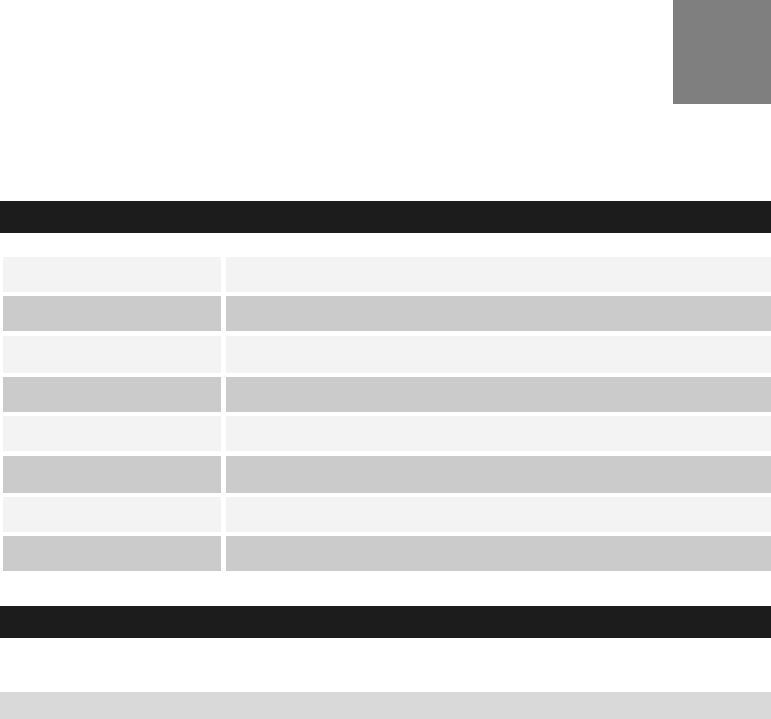
64
Appendix A
Specifications
iCamera2
Model iCamera2
Dimensions 76.8mm (W) x 76.8mm (H) x 32.7mm (D) (without stand)
Operating Temperature 0° C to 45° C
Video compression H.264 and MJPEG
Network Interface 1 Ethernet 10/100BaseT (RJ45)
Storage Temperature -20° C to 60° C
LEDs 3
Power Adapter 12V/1A
A

FC
C
This
acc
o
ther
e
caus
equi
p
mea
s
To
a
resp
o
onl
y
FC
C
This
envi
r
cent
i
This
con
d
(1)
T
(2)
T
ope
r
This
tran
s
C
Statem
e
s
equipment g
e
o
rdance with t
h
e
is no guara
n
s
e harmful int
e
p
ment off an
d
s
ures:
Reorient or
Increase th
e
Connect th
e
connected.
Consult the
a
ssure continu
o
nsible for c
o
y
shielded inte
r
C
Radiatio
n
s
equipment c
o
r
onment. Thi
s
im
eters betw
e
s
device comp
d
itions:
T
his device m
a
T
his device m
u
r
ation.
s
transmitter
m
s
mitter.
e
nt
e
nerates, uses
h
e instructio
n
n
tee that inter
f
e
rference to r
a
d
on, the user
relocate the r
e
e
separation b
e
e
equipment i
n
dealer or an
e
ed complianc
o
mpliance co
u
r
face cables
w
n
Exposur
e
o
mplies with
F
s
equipment s
h
e
en the radiat
o
lies with Part
a
y not cause
h
u
st accept an
y
m
ust not be co
and can radi
a
s, may cause
h
fe
rence will n
o
a
dio or televi
s
i
s encourage
d
e
ceiving ante
n
e
tween the eq
u
n
to an outlet
o
e
xperienced r
a
e
, any chang
e
u
ld void the u
s
w
hen connecti
e
Stateme
n
F
CC RF radi
a
h
ould be inst
a
o
r and your b
o
15 of the FC
C
h
armful inter
fe
y
interference
-
located or o
p
a
te radio freq
u
harmful inter
f
o
t occur in a
p
s
ion reception
d
to try to cor
r
n
na.
u
ipment and
r
o
n a circuit di
f
a
dio/TV tech
n
e
s or modifica
t
s
er's authority
i
ng to comput
e
n
t
a
tion exposur
e
a
lled and ope
r
o
dy.
C
Rules. Ope
r
f
erence, and
received, inc
l
p
erating in co
n
u
ency energy
a
f
erence to rad
p
articular inst
a
,
which can b
e
r
ect the interf
e
r
eceiver.
f
ferent from t
h
n
ician for hel
p
t
ions not exp
r
to operate th
i
e
r or periphe
r
e
limits set fo
r
r
ated with a
m
r
ation is subje
l
uding interfe
r
n
junction wit
h
a
nd, if not in
s
i
o communic
a
a
llation. If thi
s
e
determined
b
e
rence by one
h
at to which t
h
.
r
essly approv
e
s equipment.
a
l devices).
r
th for an unc
o
m
inimum dista
n
ct to the follo
w
r
ence that ma
y
h
any other an
t
s
talled and us
e
a
tions. Howe
v
s
equipment
d
b
y turning th
e
of the follow
i
h
e receiver is
e
d by the part
y
(Example - u
s
o
ntrolled
n
ce of 20
wing two
y
cause unde
s
n
tenna or
e
d in
v
er,
d
oes
e
i
ng
y
s
e
s
ired

IC Approvals
CAN-ICES-3 (B)/ NMB-3(B)
This device complies with RSS-210 of the Industry Canada Rules. Operation is subject to the following
two conditions: (1) This device may not cause harmful interference, and (2) this device must accept any
interference received, including interference that may cause undesired operation.
Ce dispositif est conforme à la norme CNR-210 d'Industrie Canada applicable aux appareils radio
exempts de licence. Son fonctionnement est sujet aux deux conditions suivantes: (1) le dispositif ne
doit pas produire de brouillage préjudiciable, et (2) ce dispositif doit accepter tout brouillage reçu, y
compris un brouillage susceptible de provoquer un fonctionnement indésirable.
Radiation Exposure Statement:
This equipment complies with IC radiation exposure limits set forth for an uncontrolled environment.
This equipment should be installed and operated with minimum distance 20cm between the radiator &
your body.
Déclaration d'exposition aux radiations:Cet équipement est conforme aux limites d'exposition aux
rayonnements IC établies pour un environnement non contrôlé. Cet équipement doit être installé et
utilisé avec un minimum de 20 cm de distance entre la source de rayonnement et votre corps.
CE Approvals
This is a Class B product. In a domestic environment this product may cause radio interference in
which case the user may be required to take adequate measures.